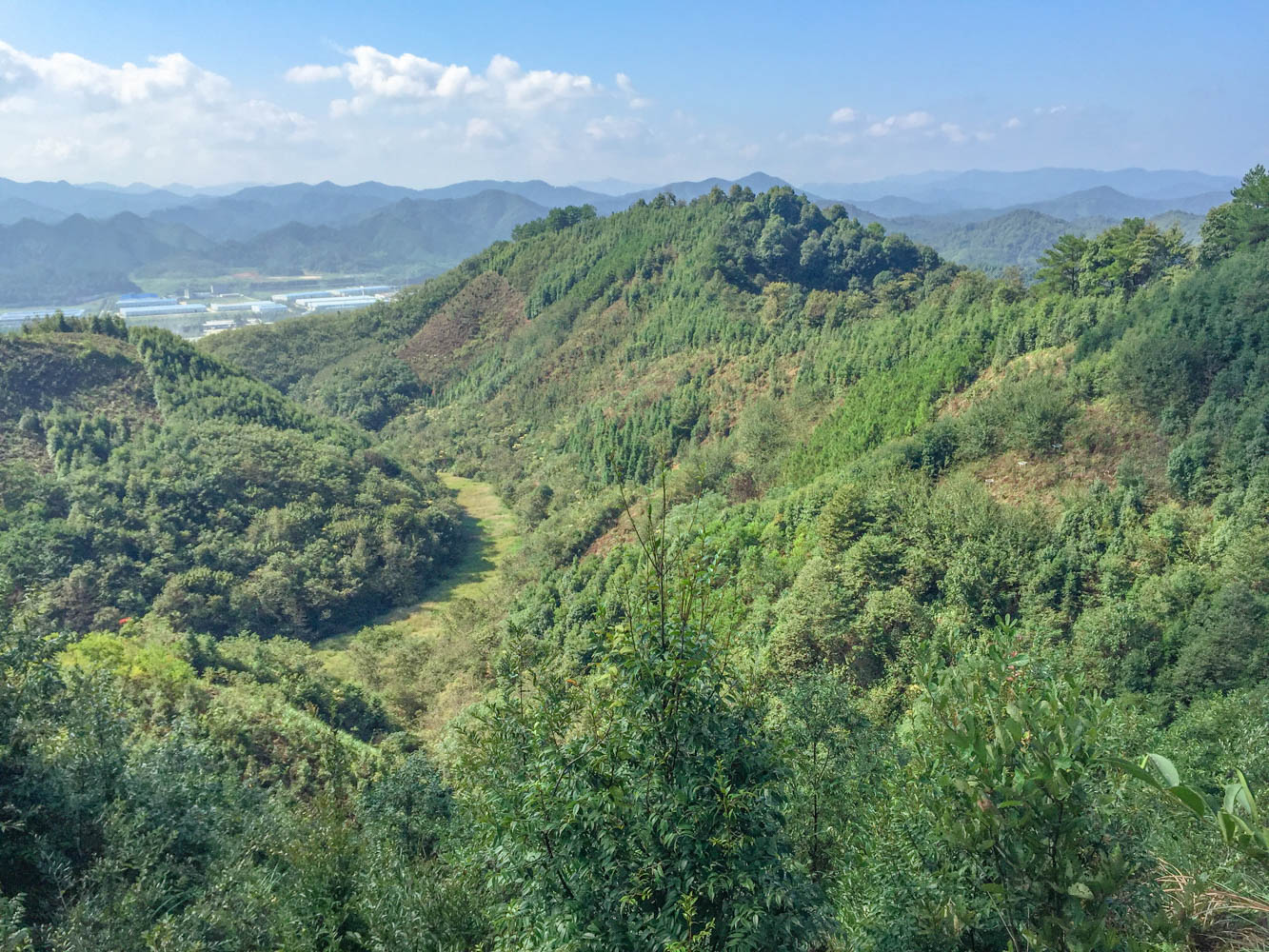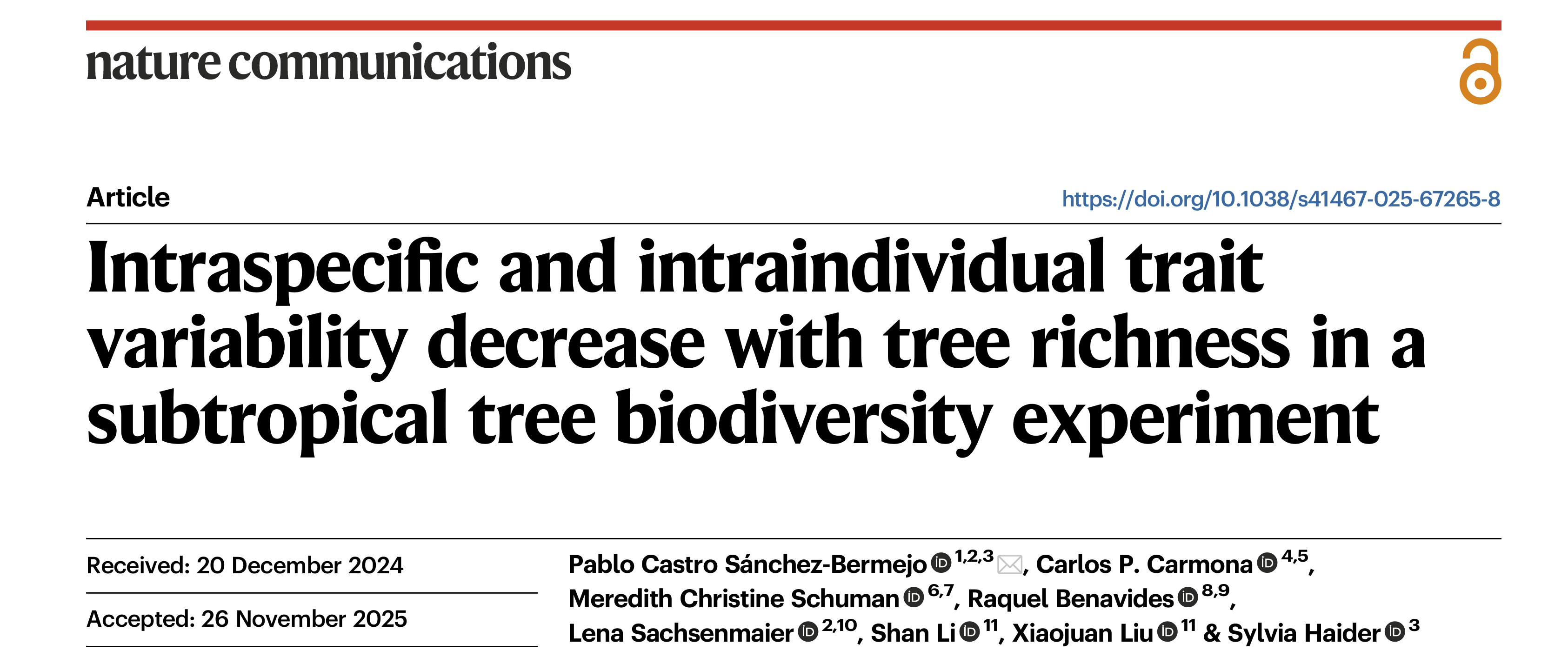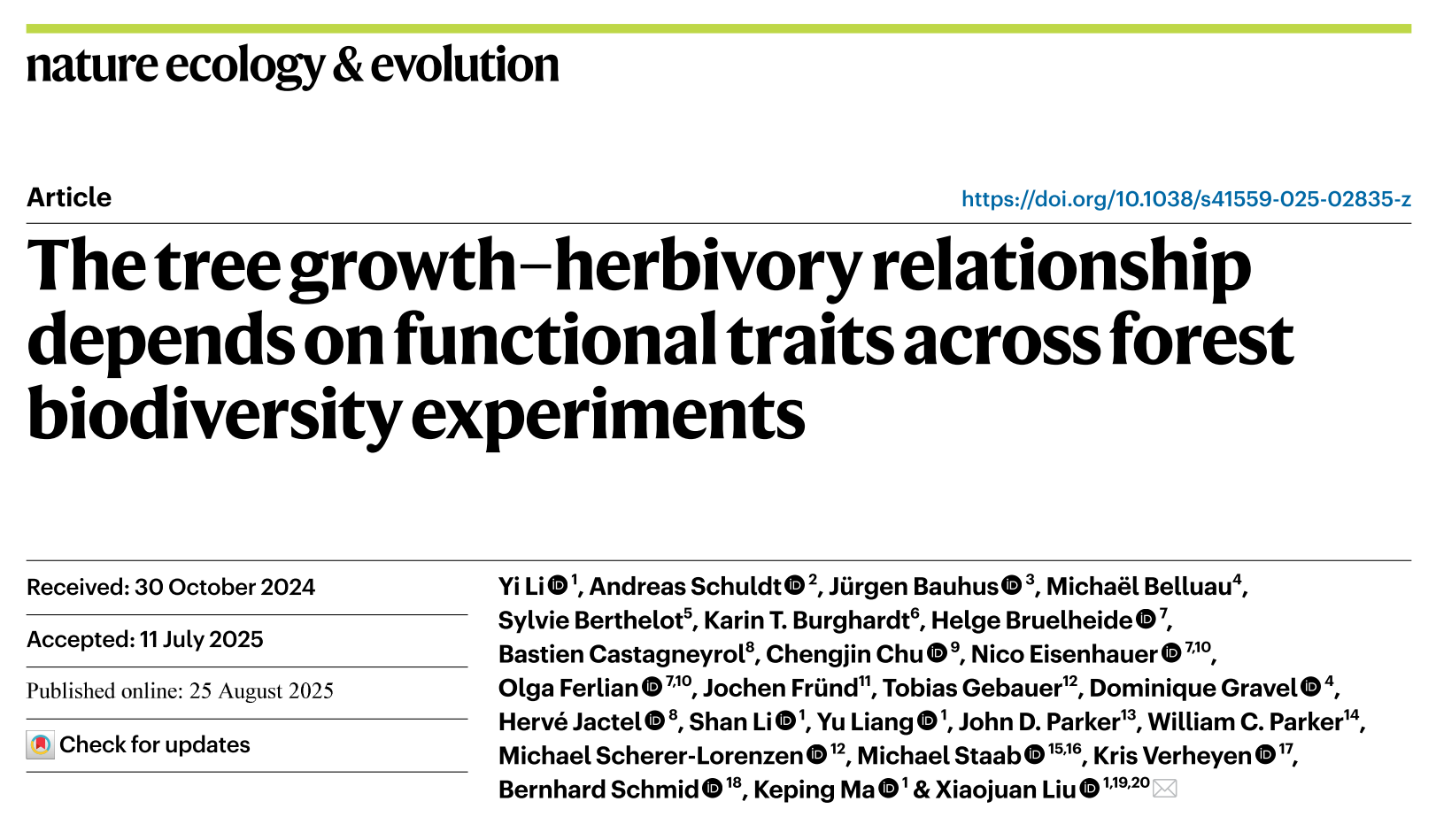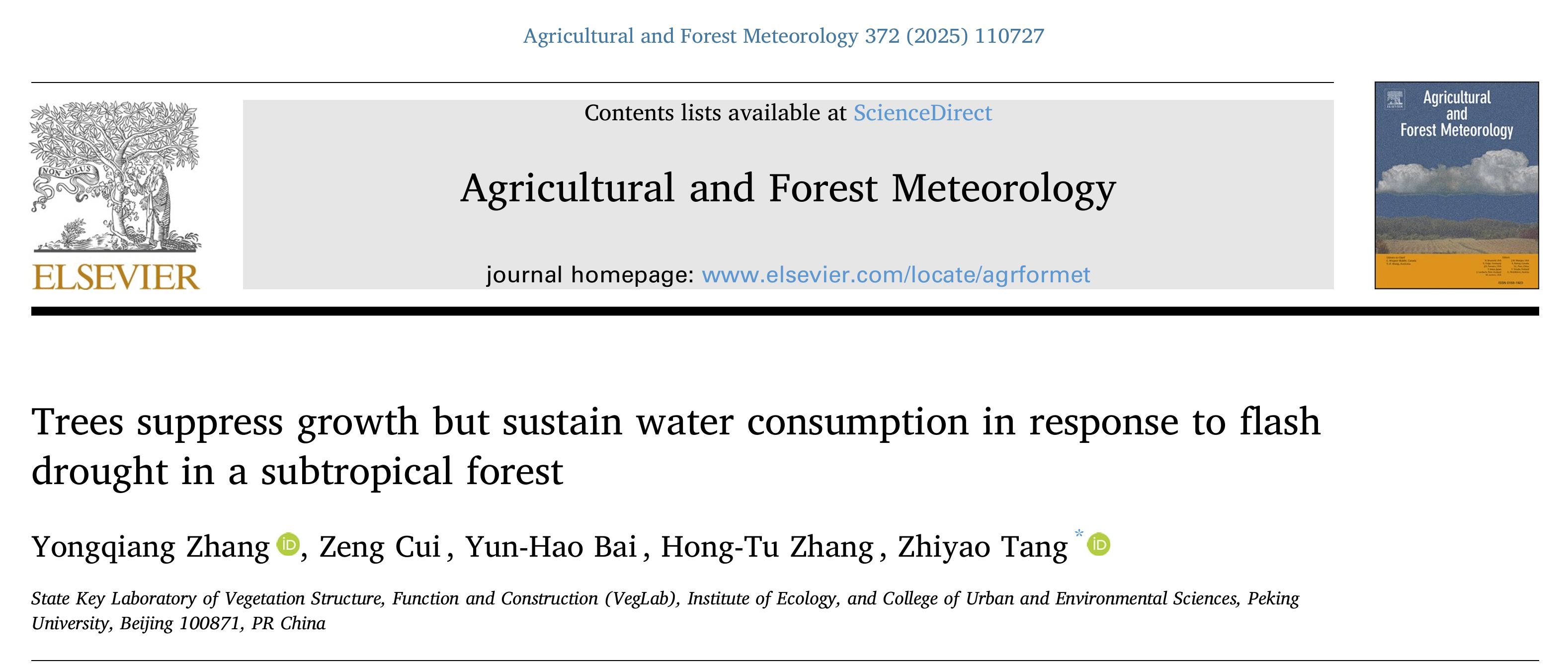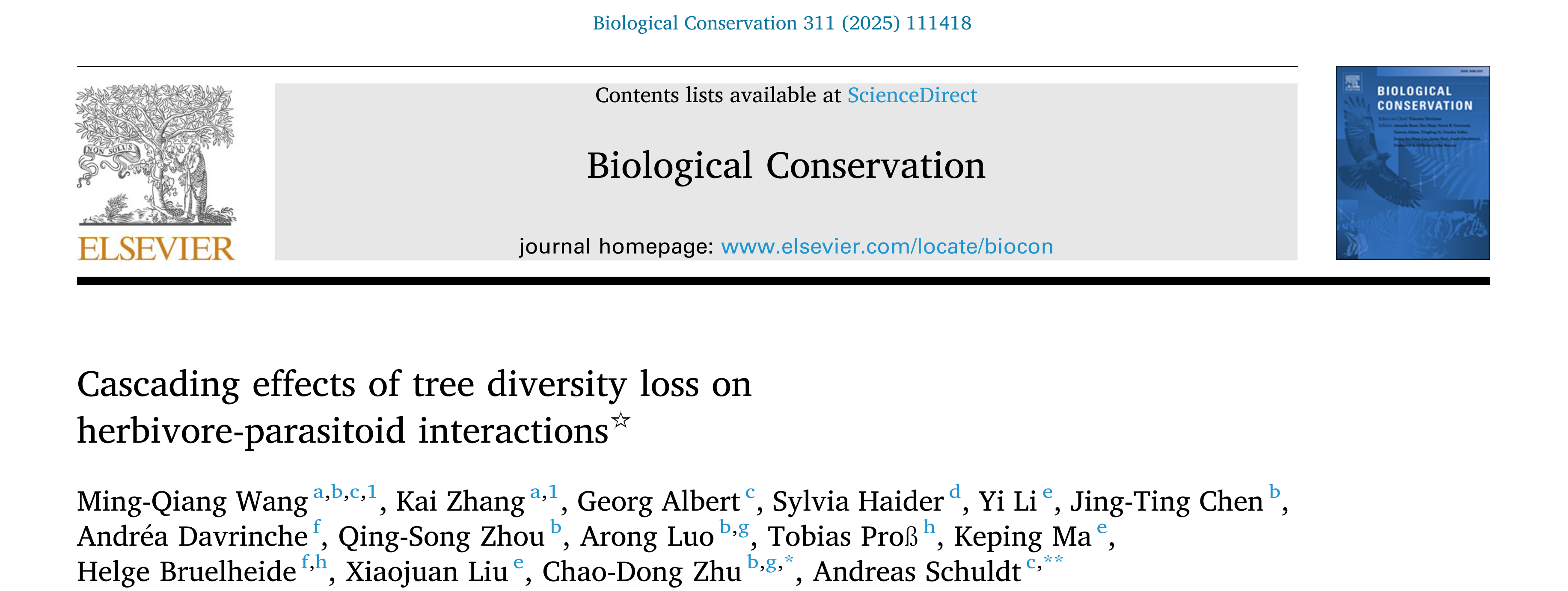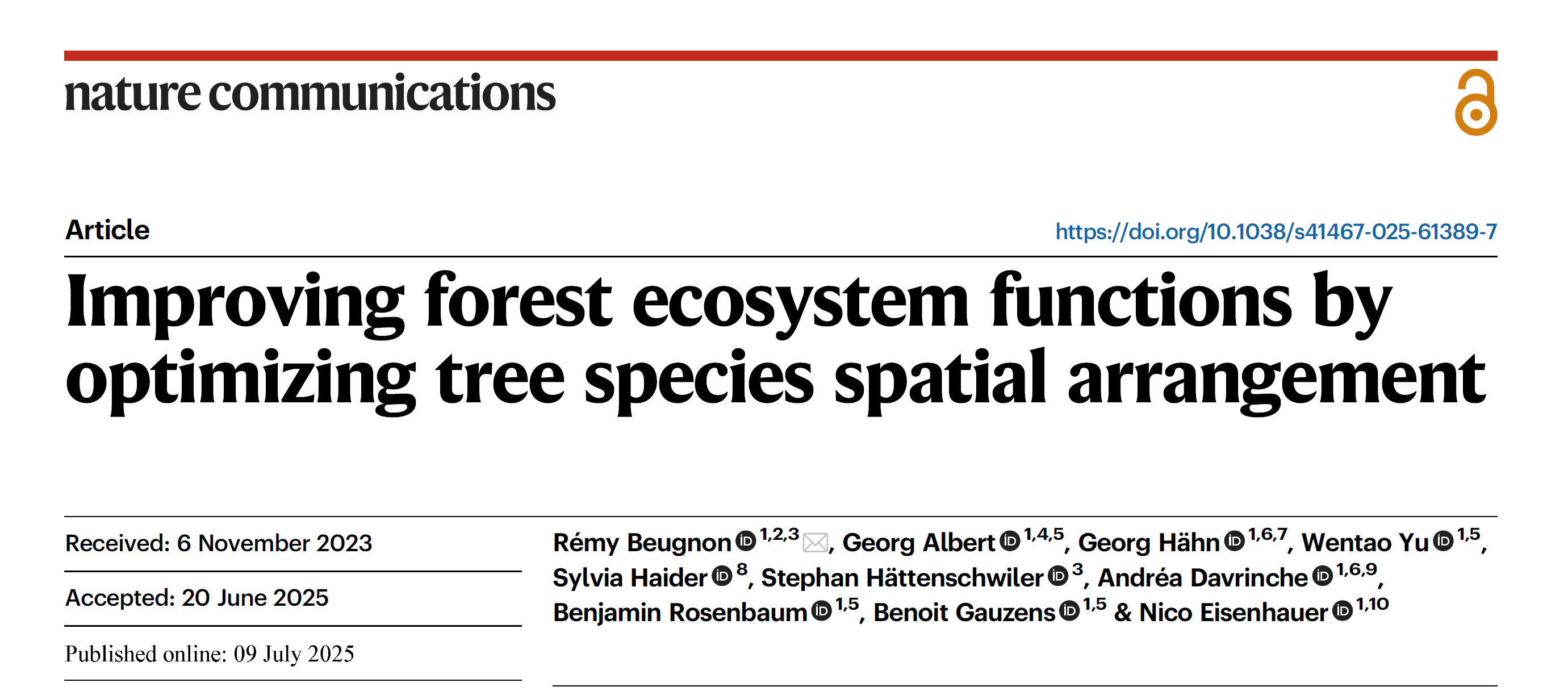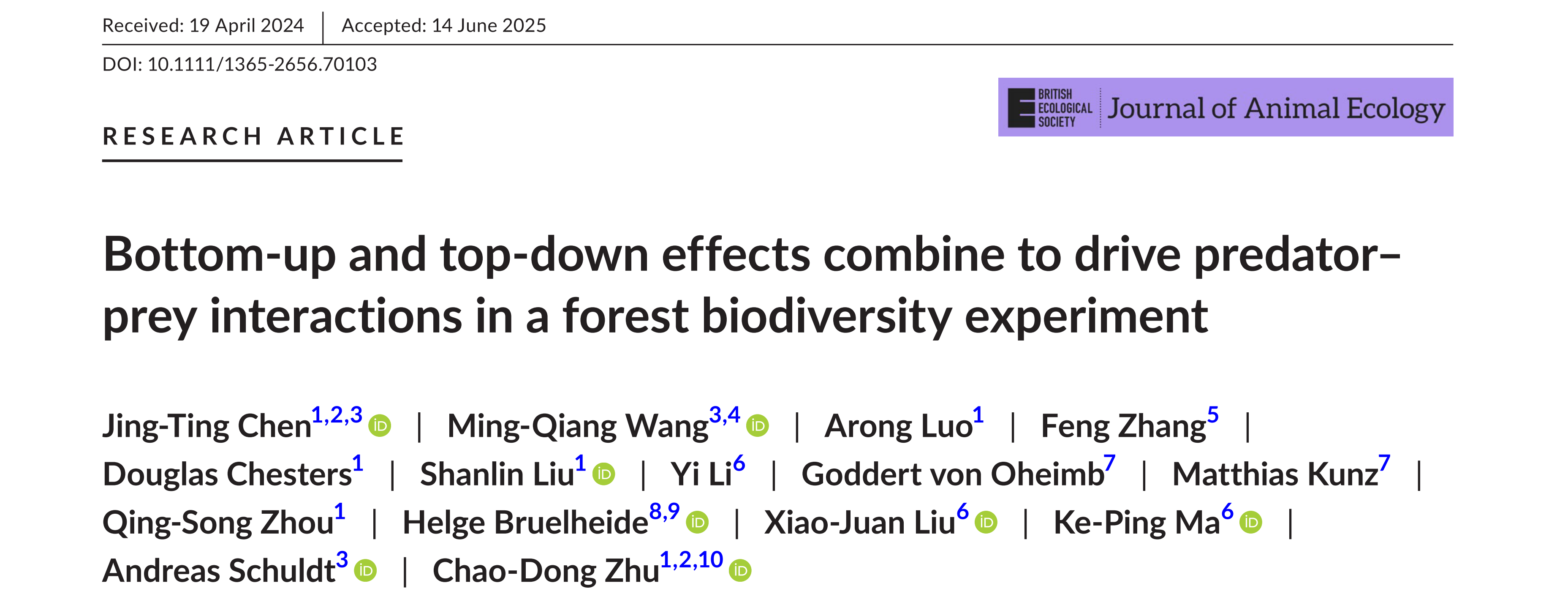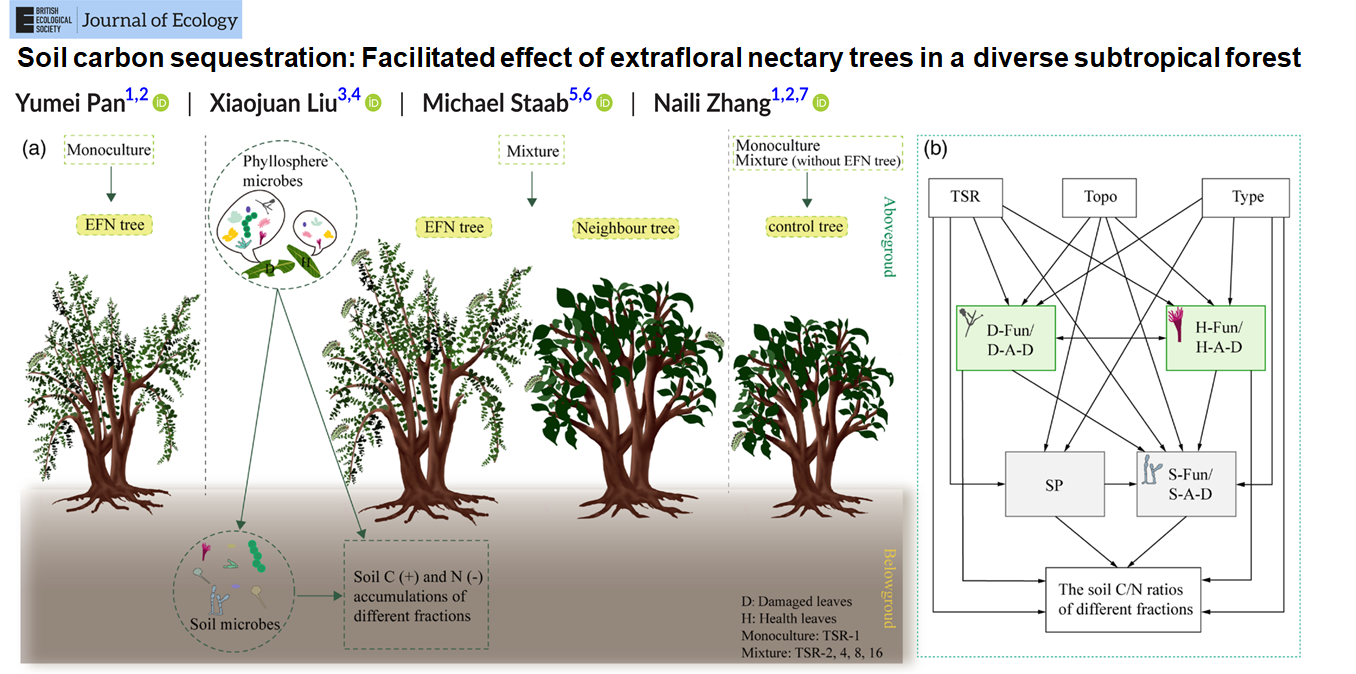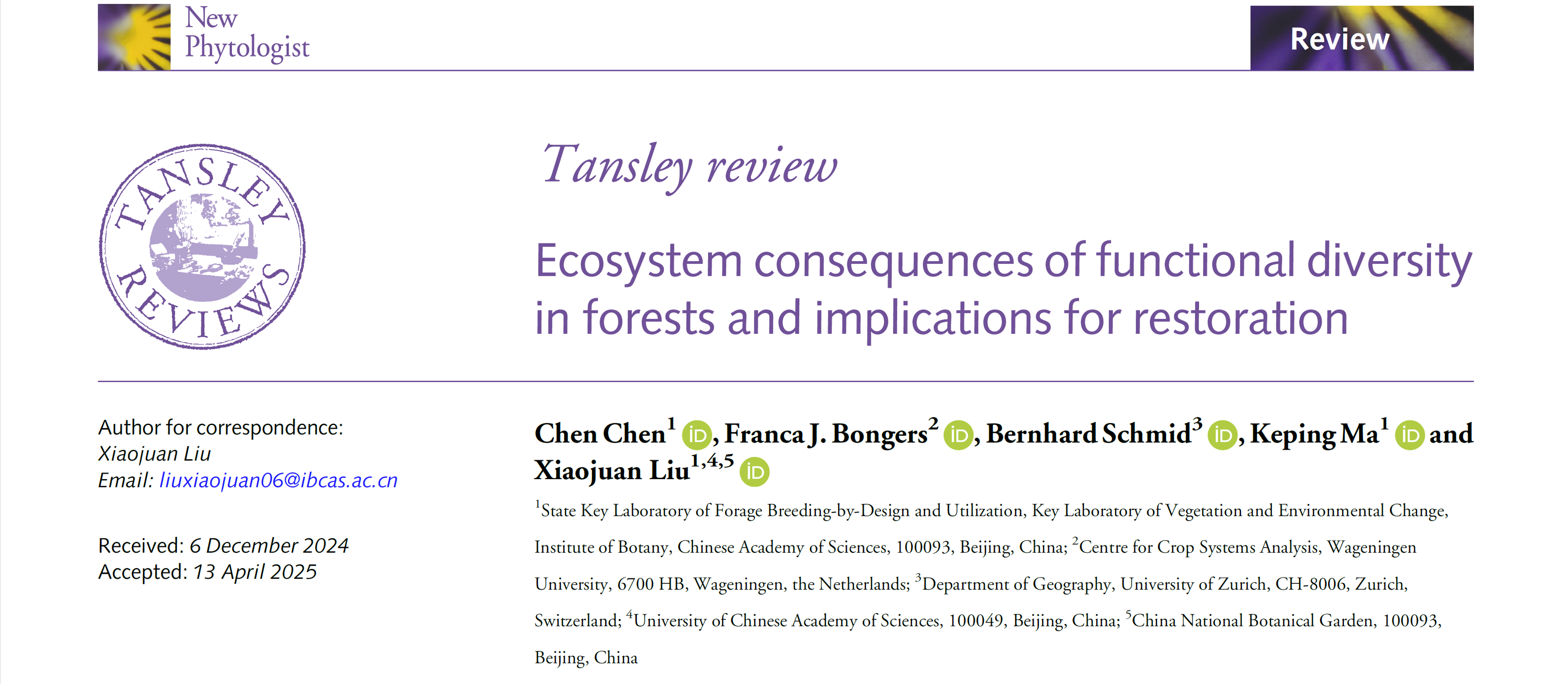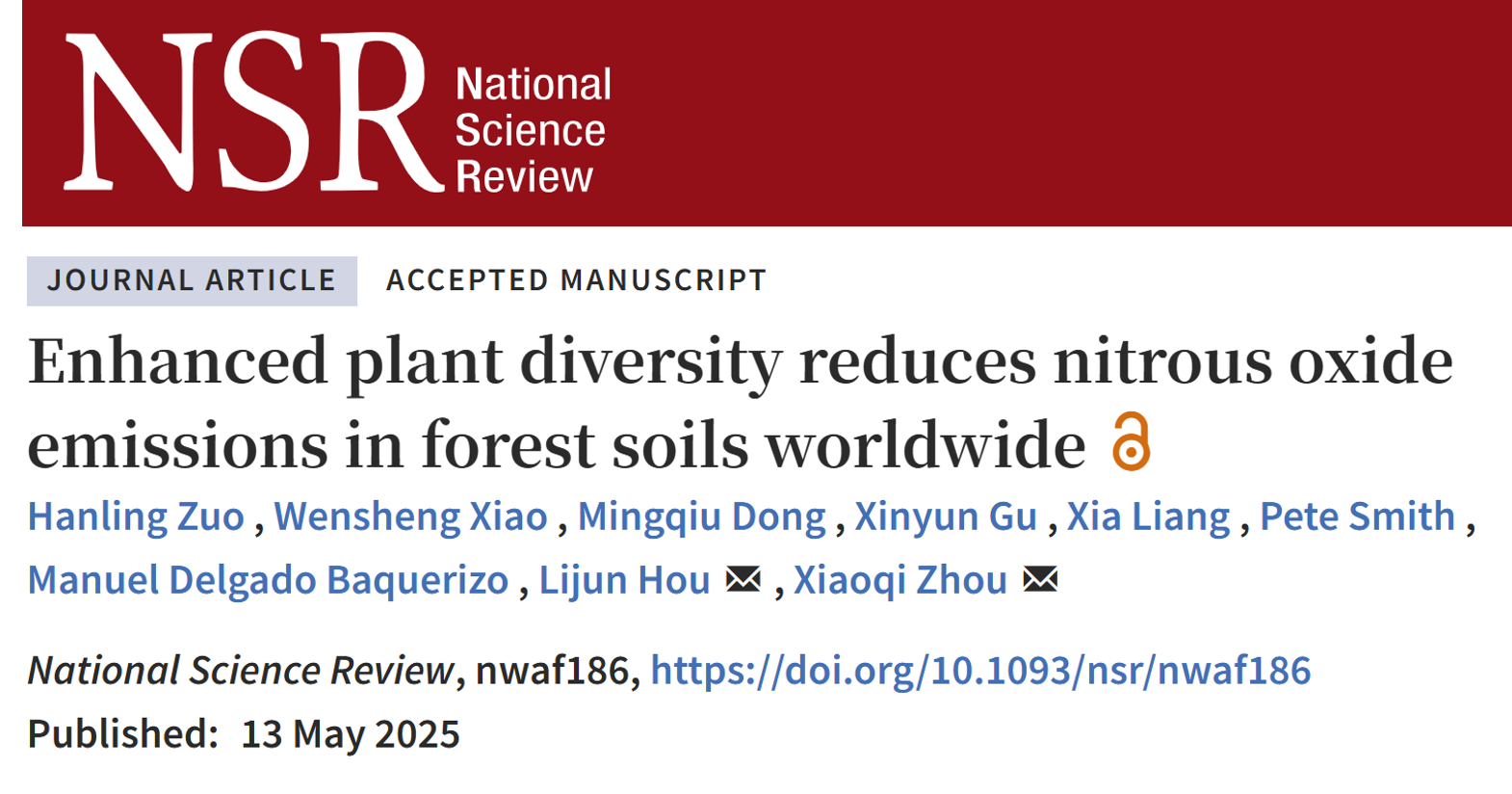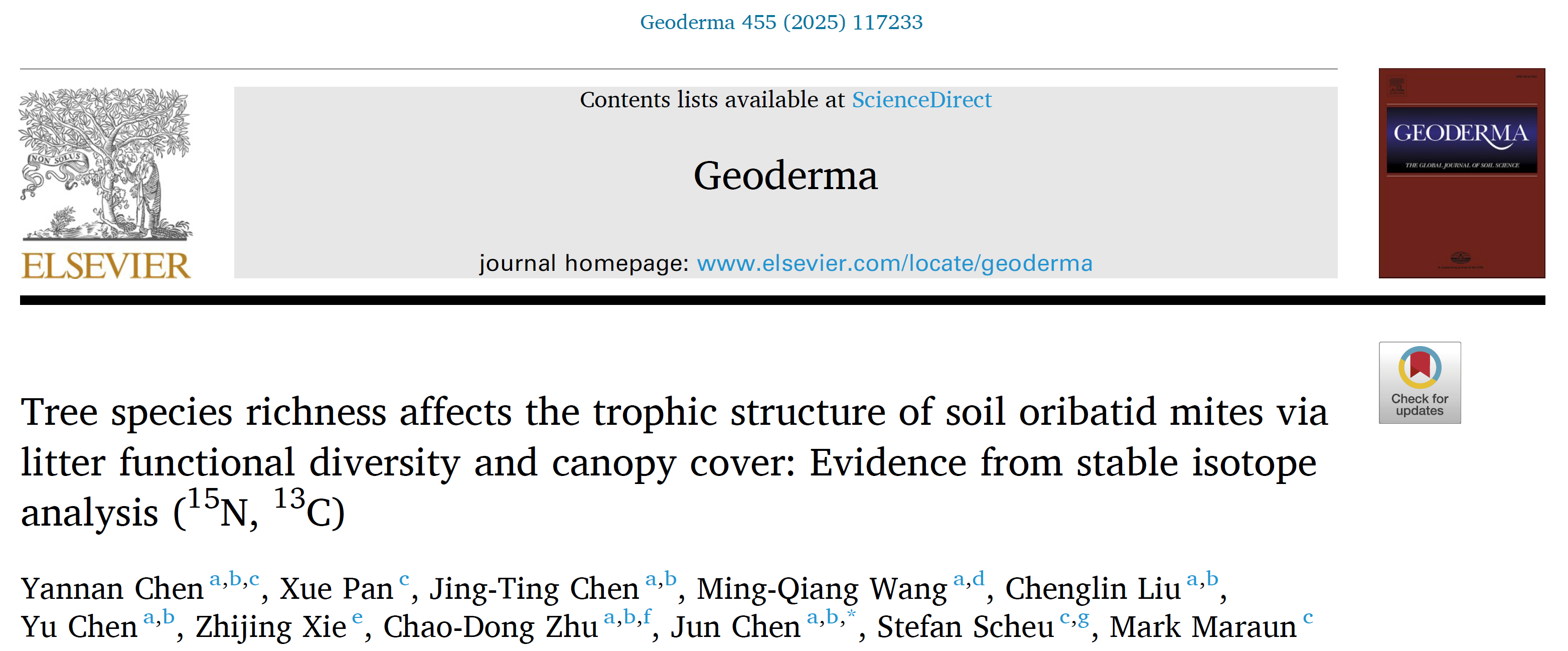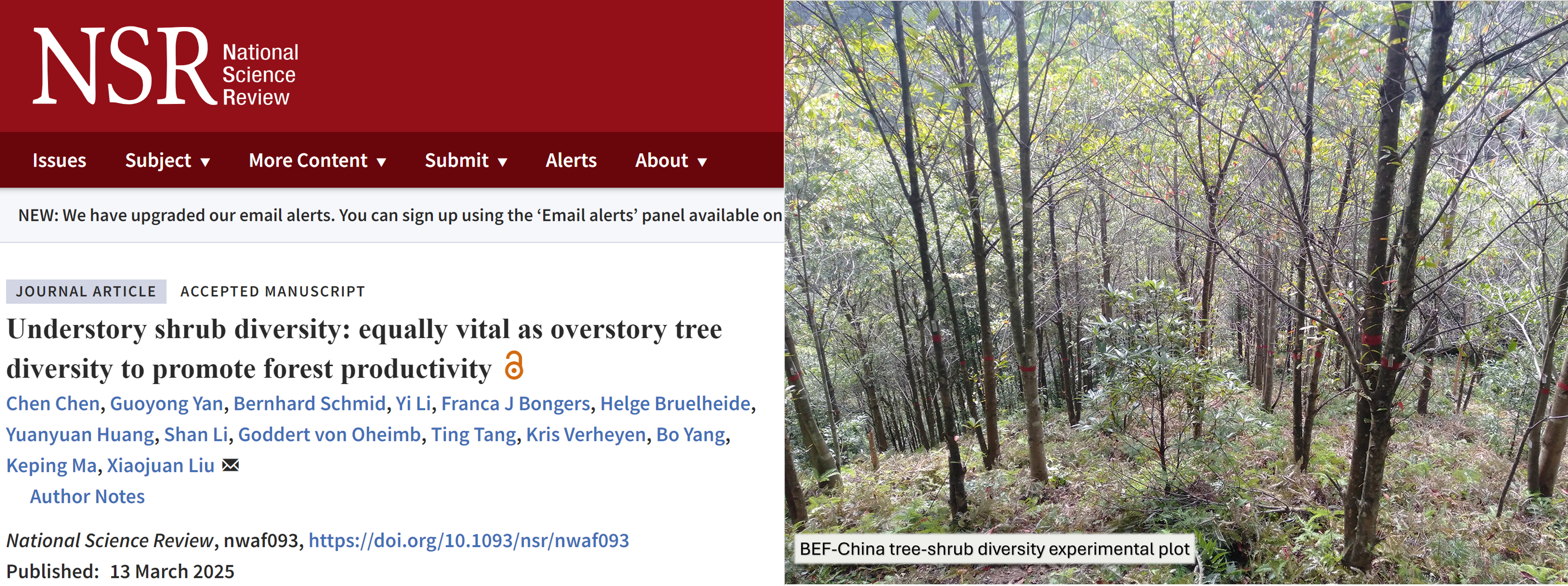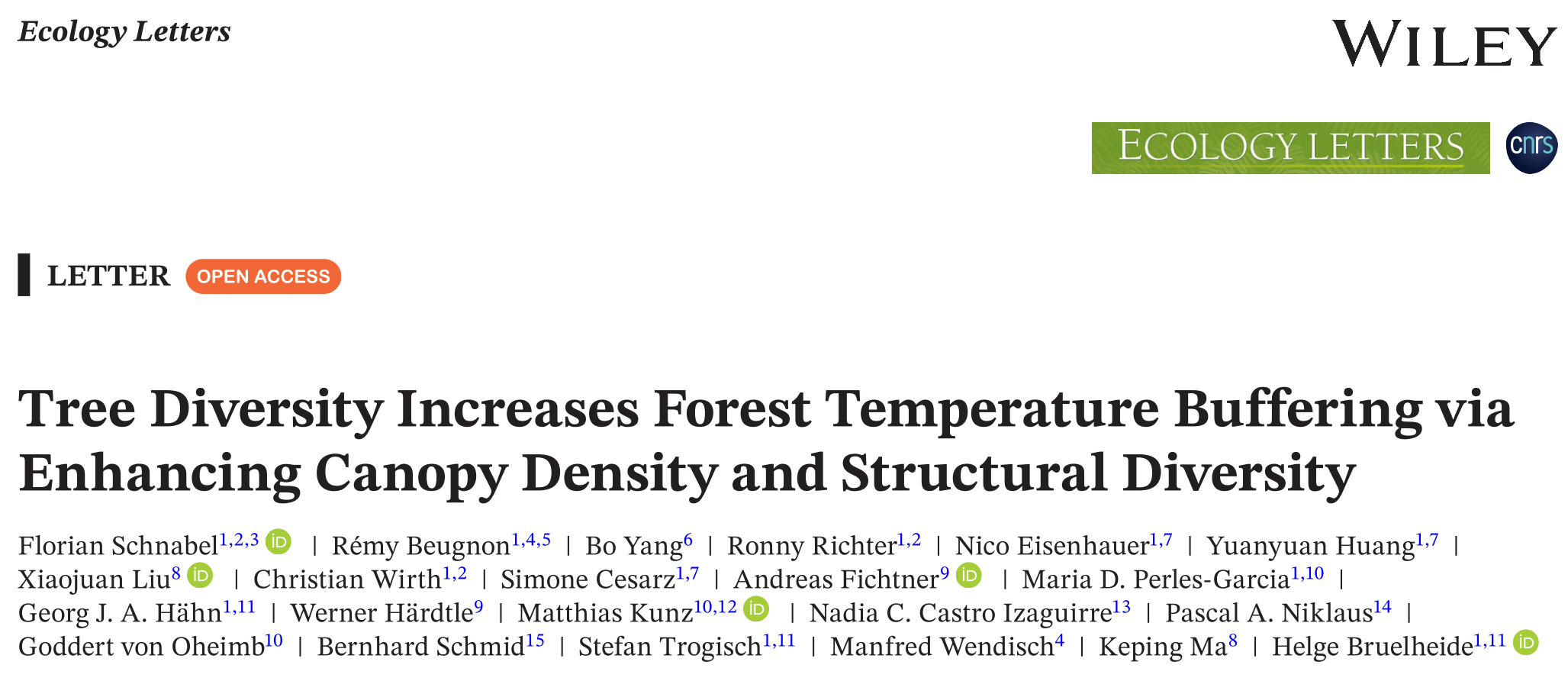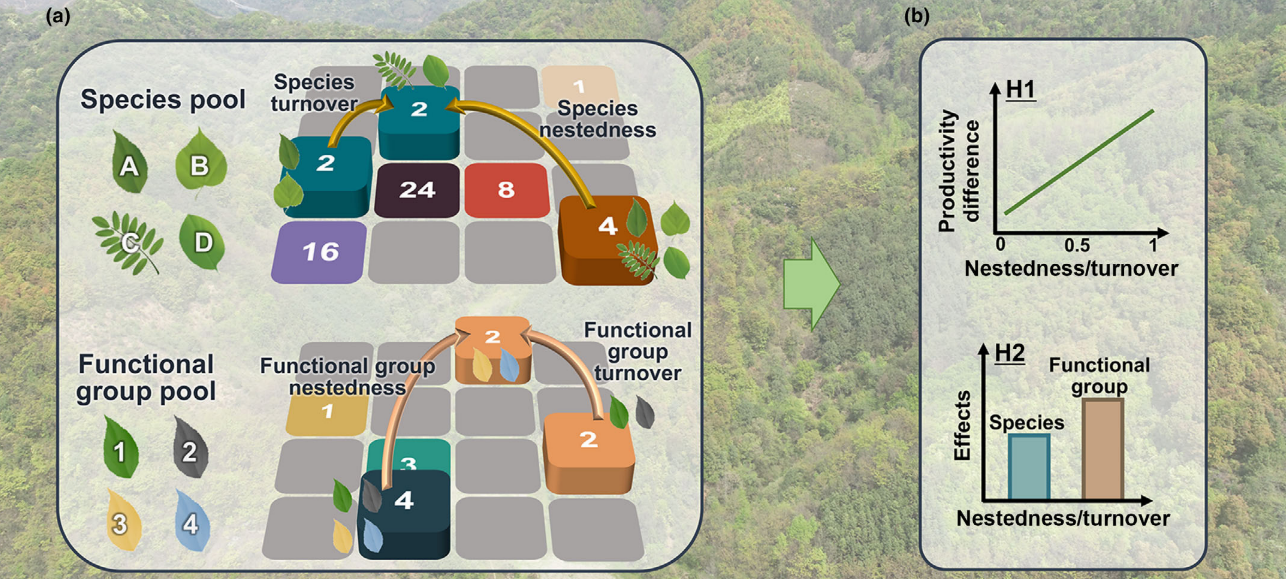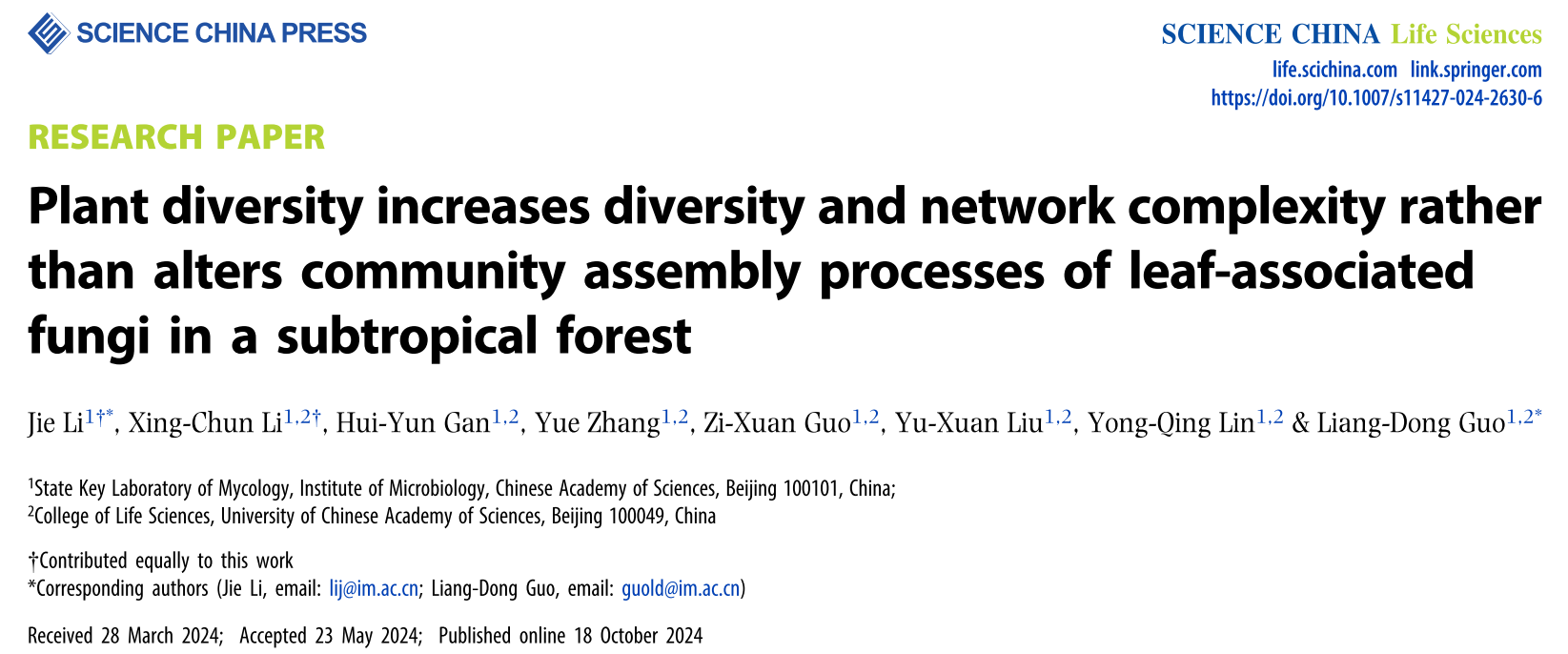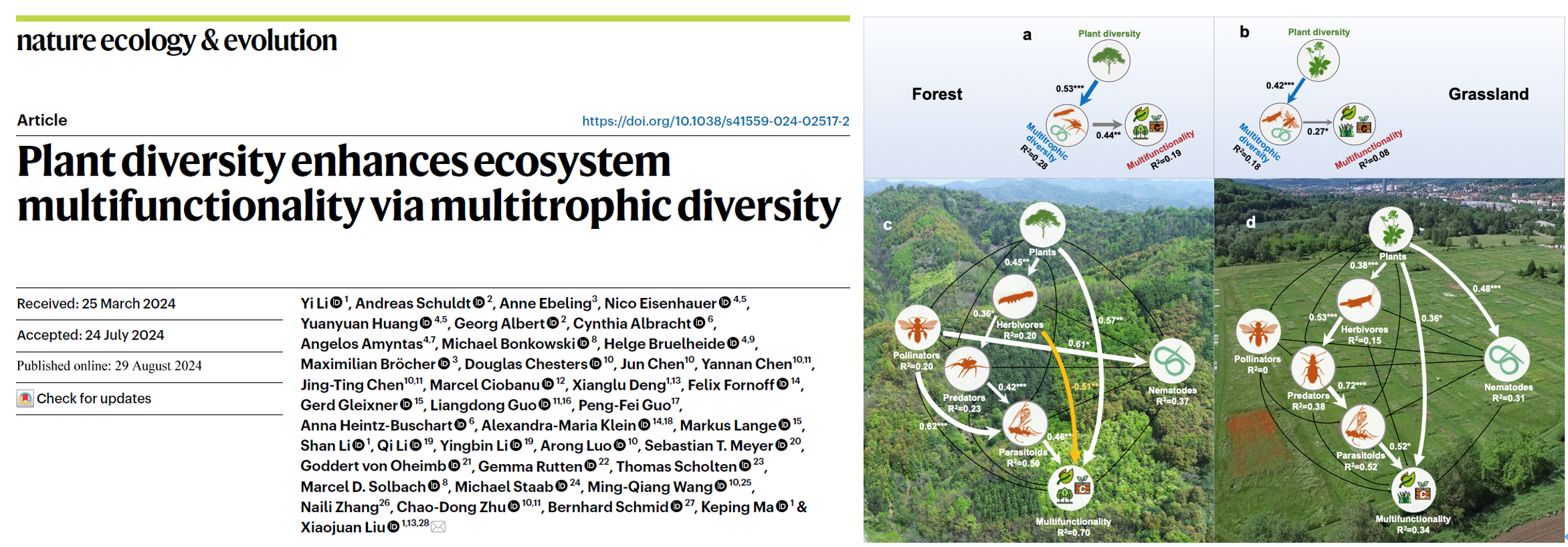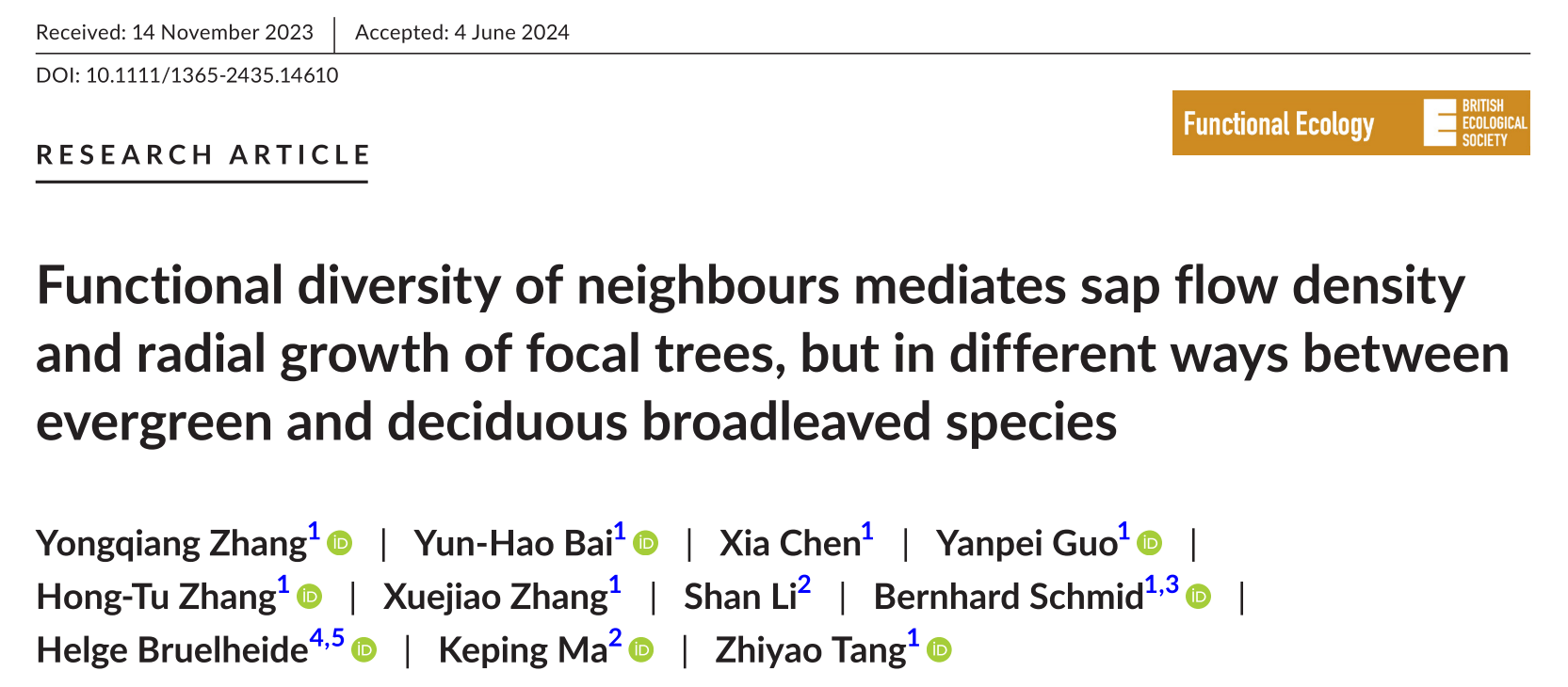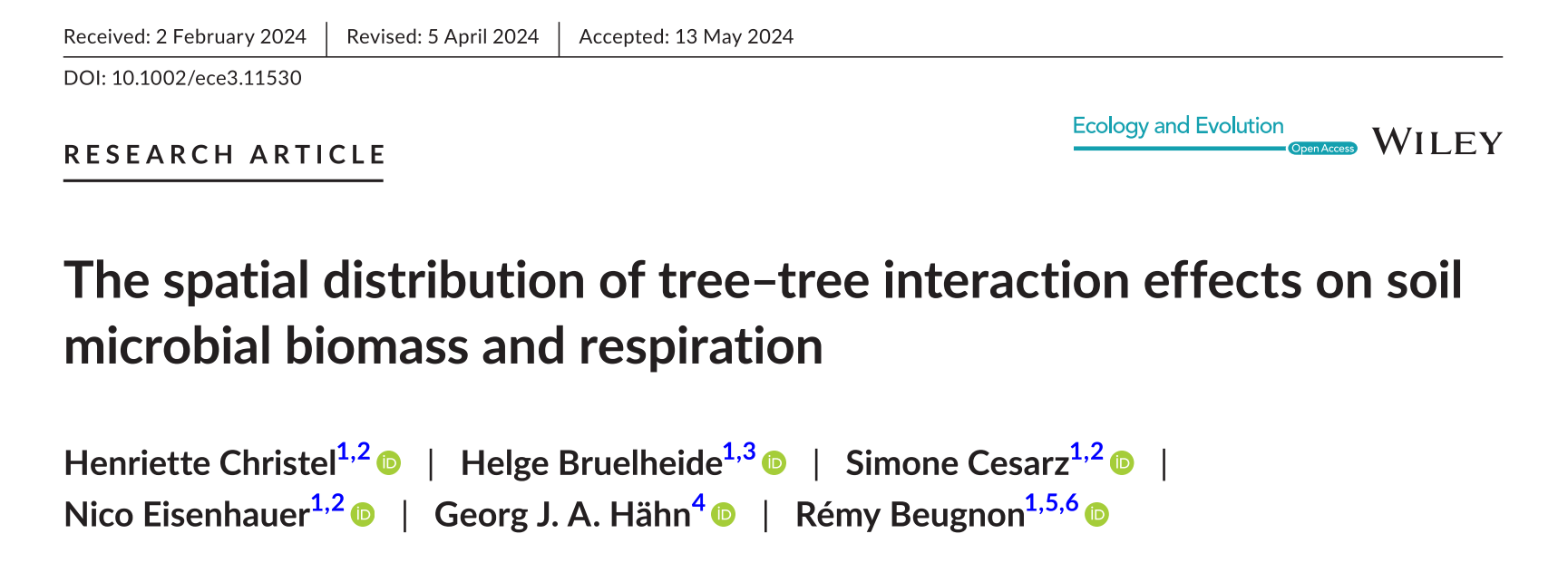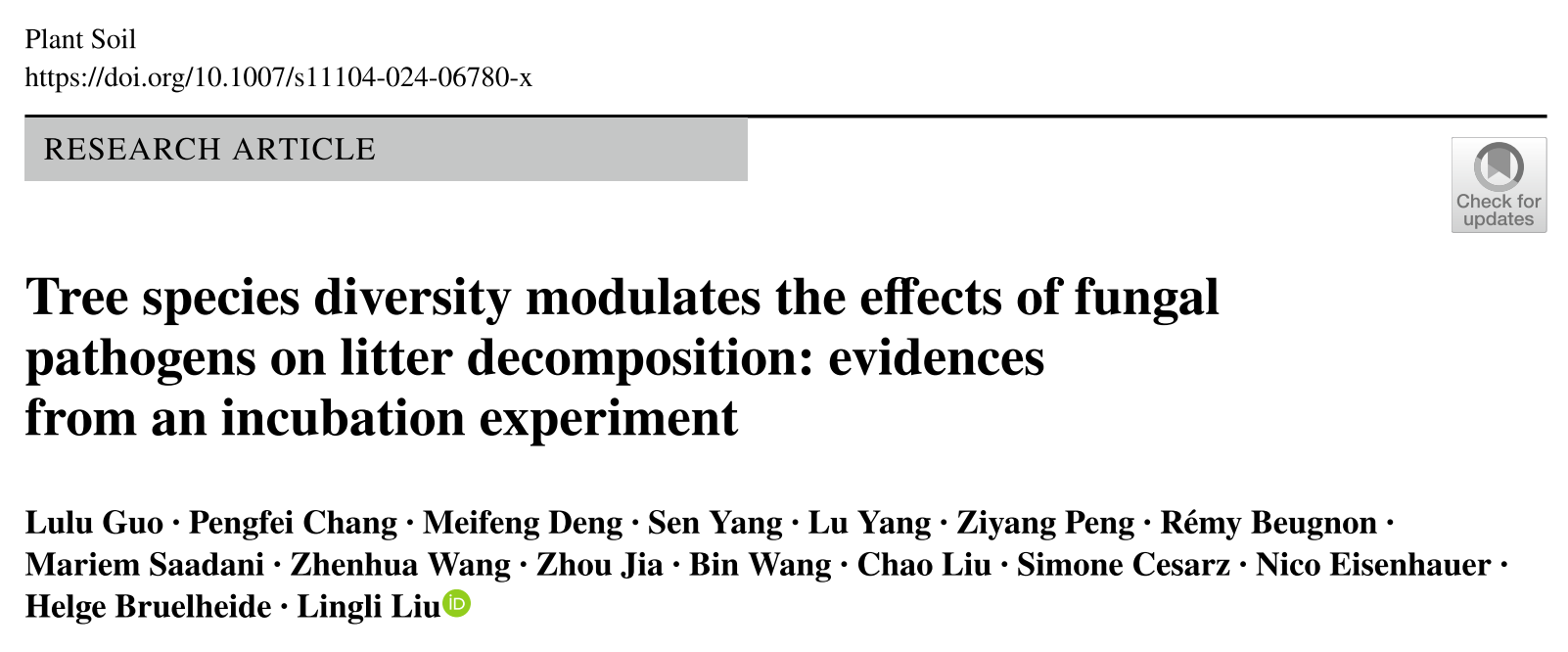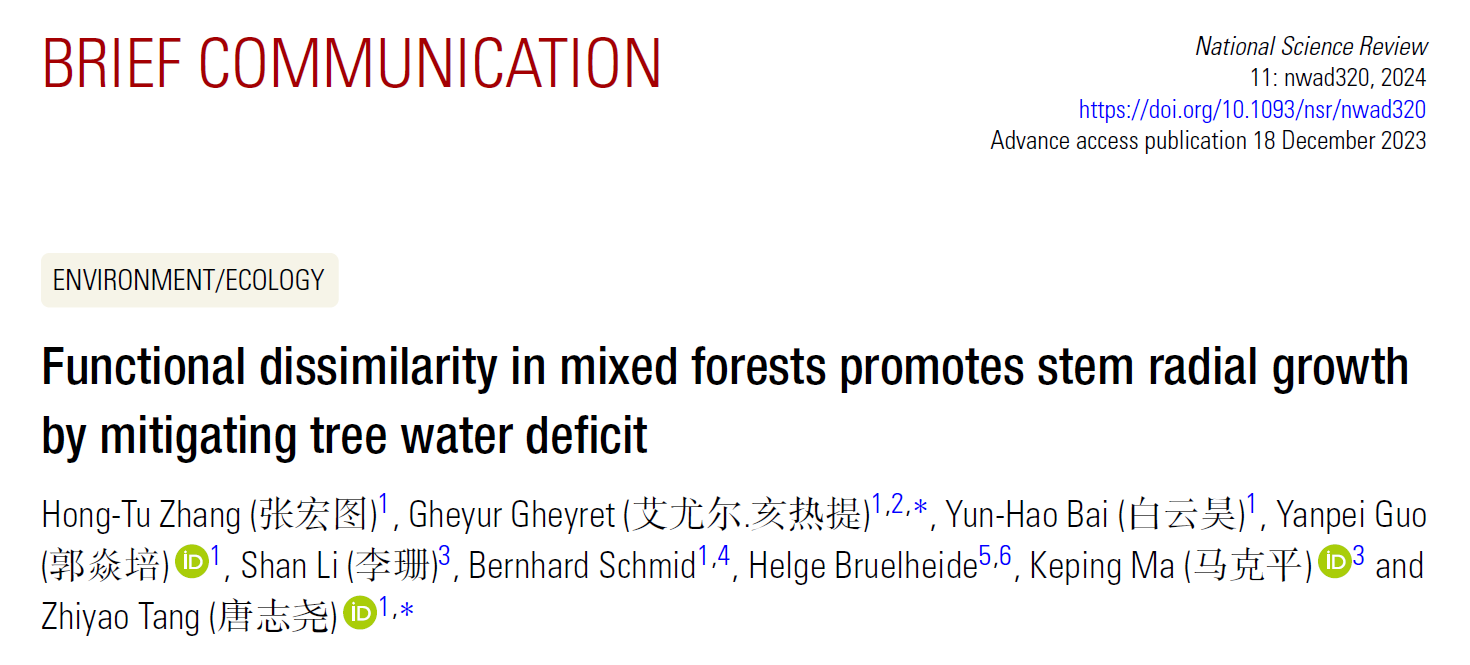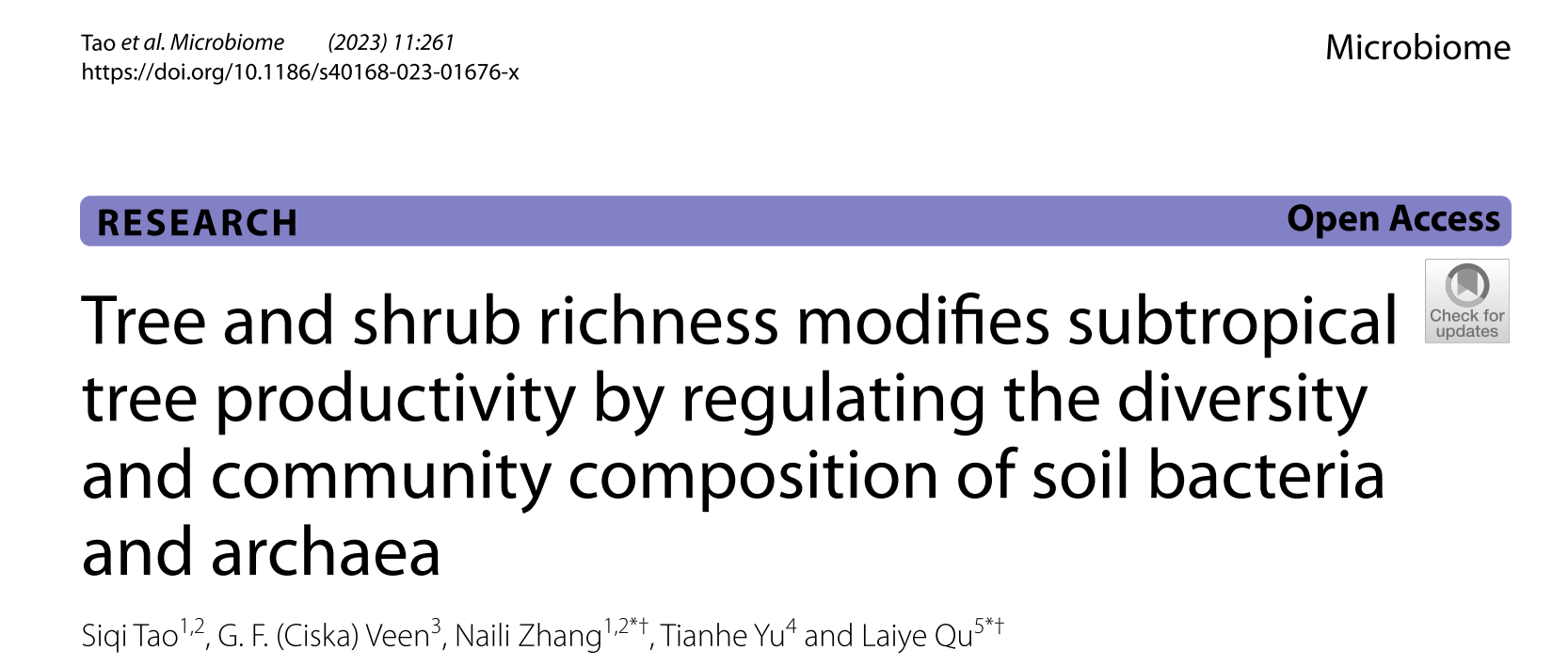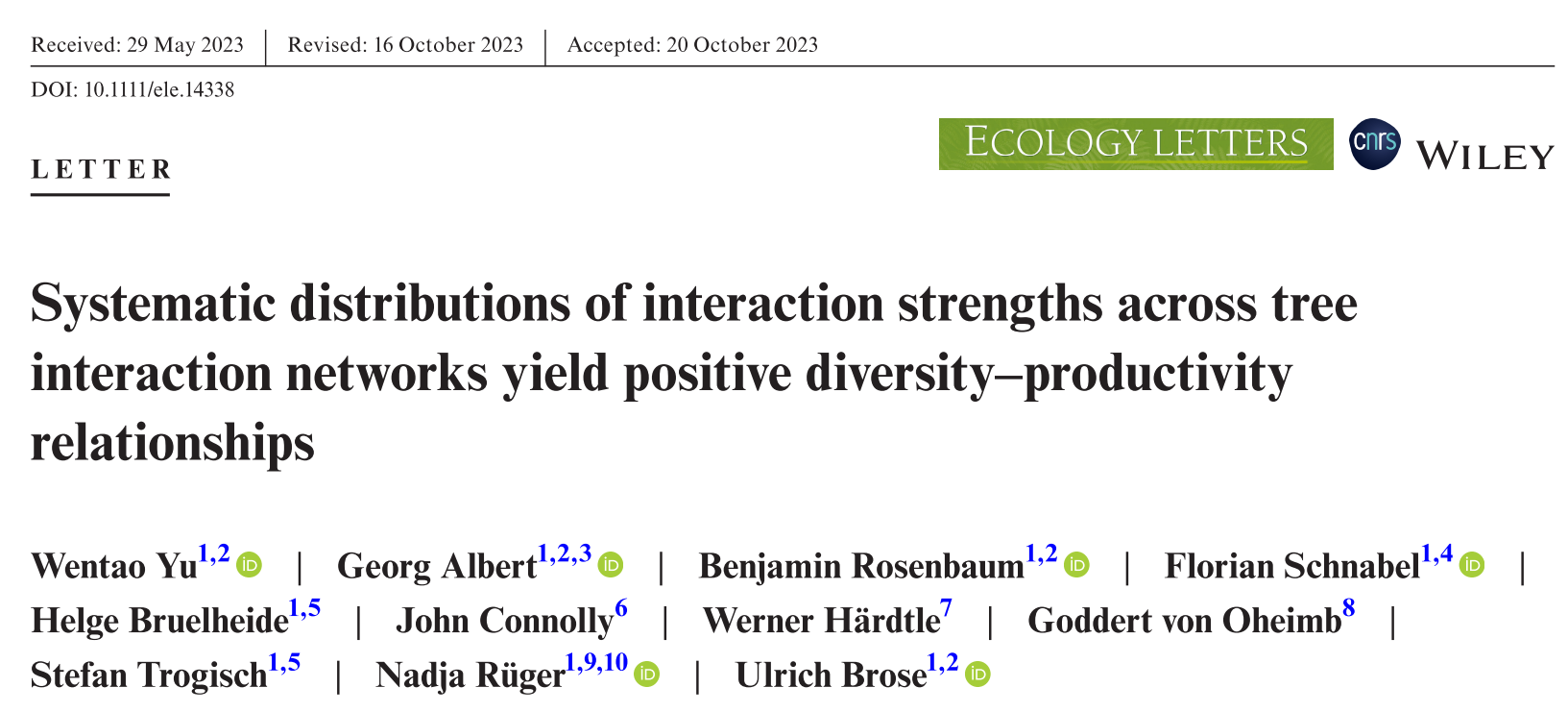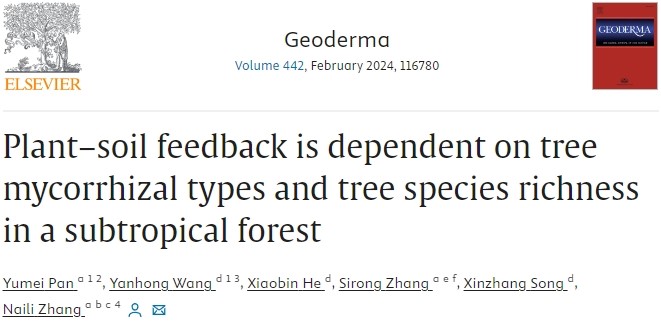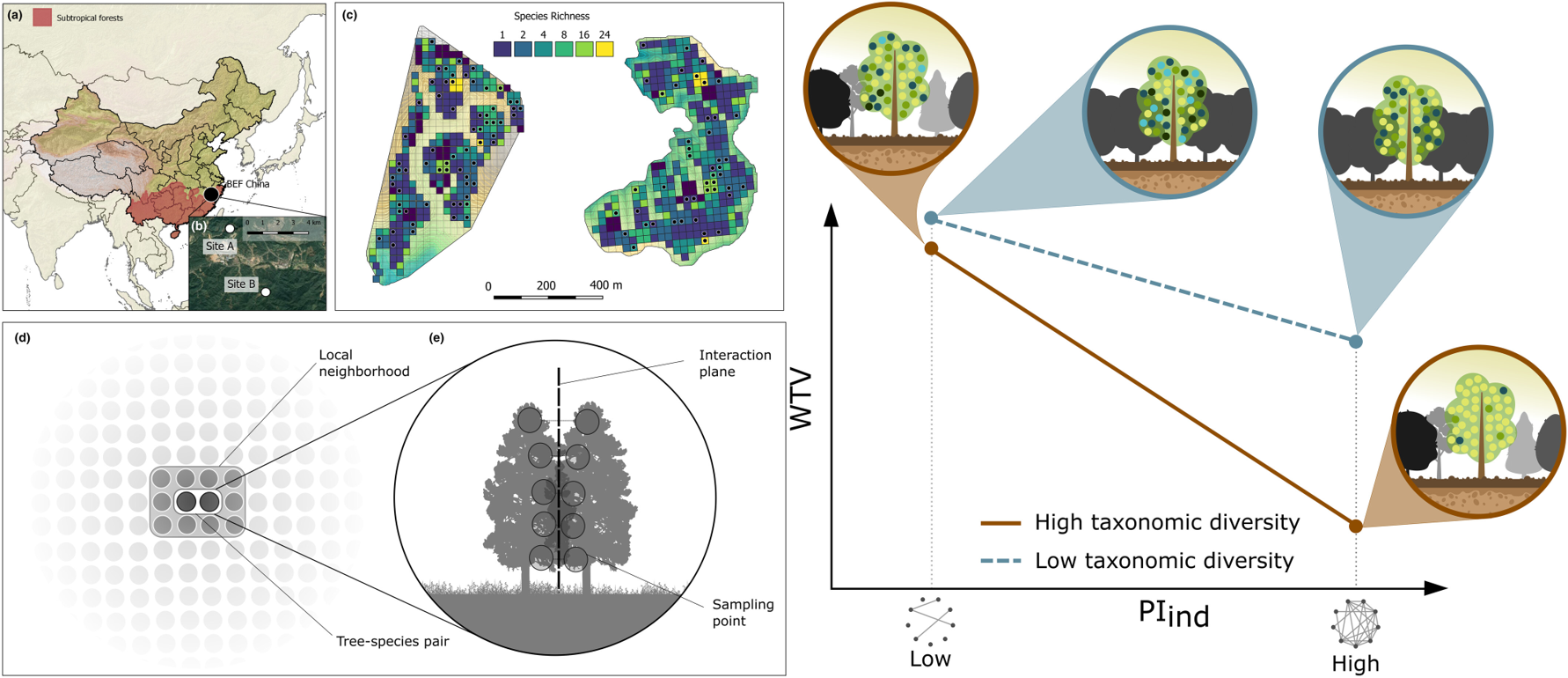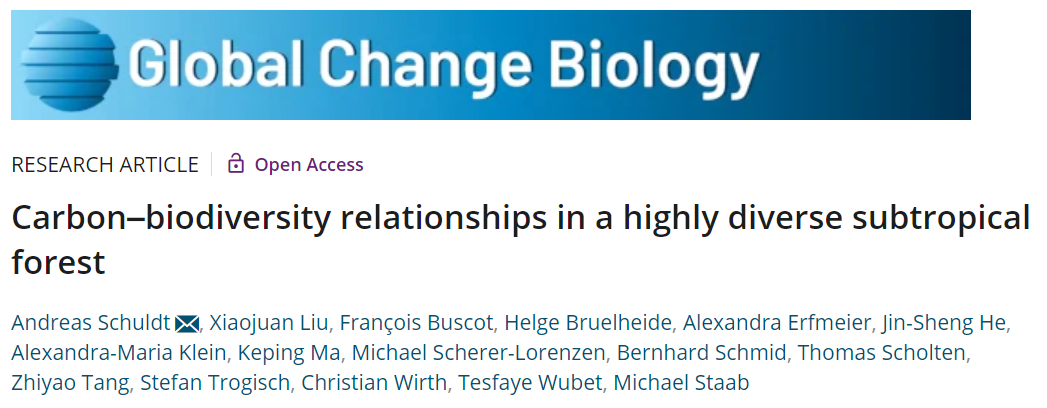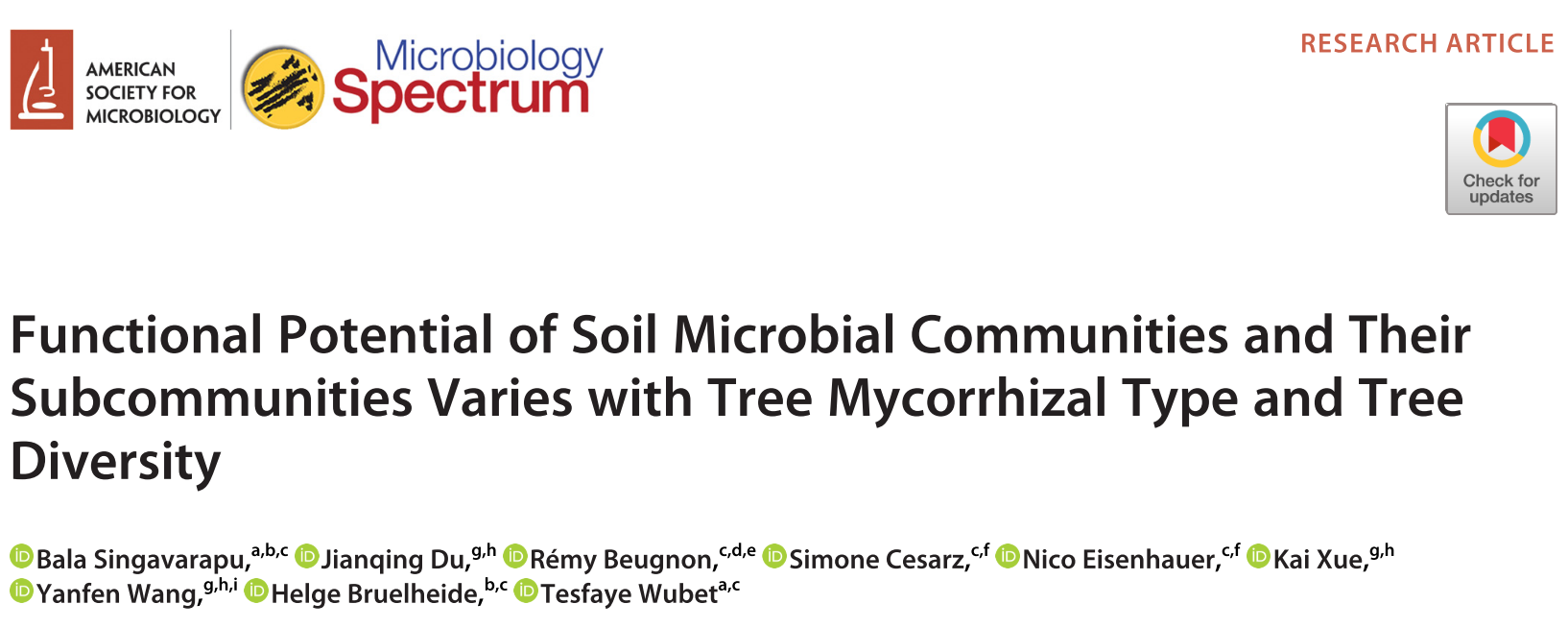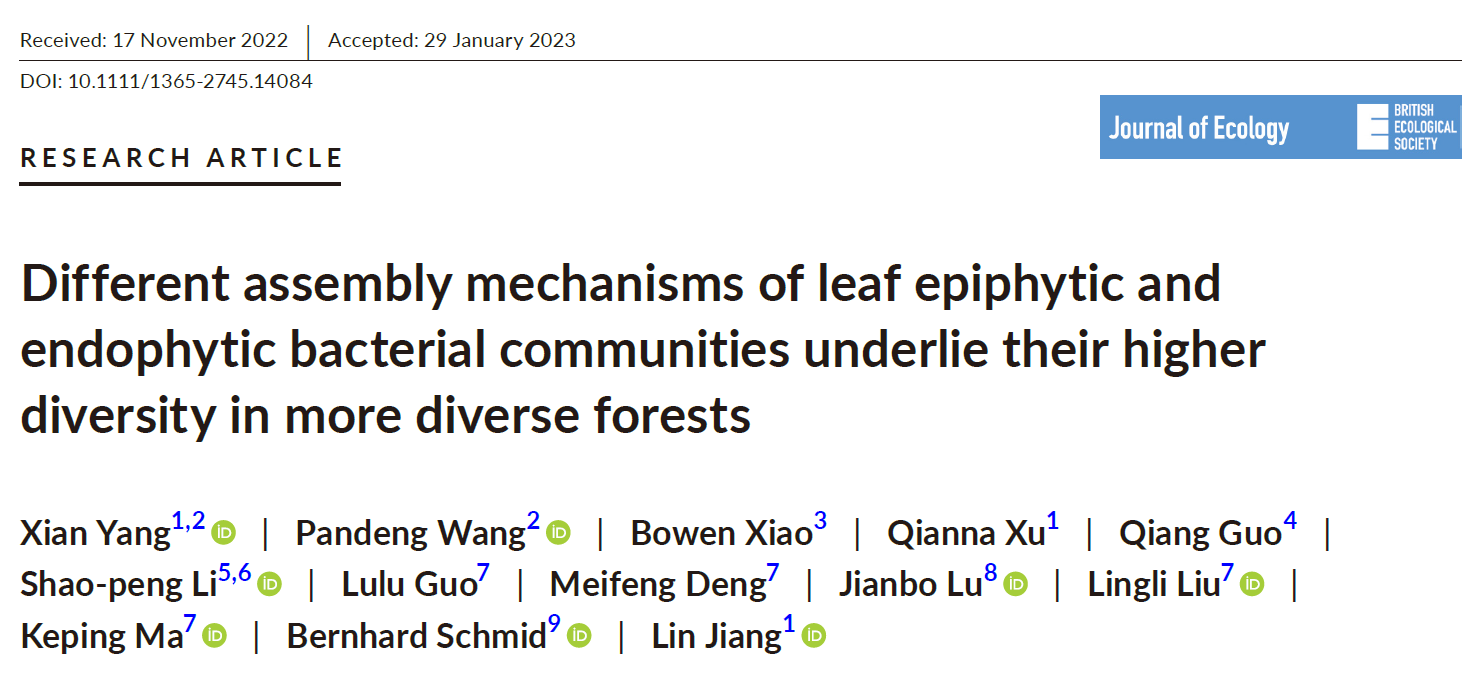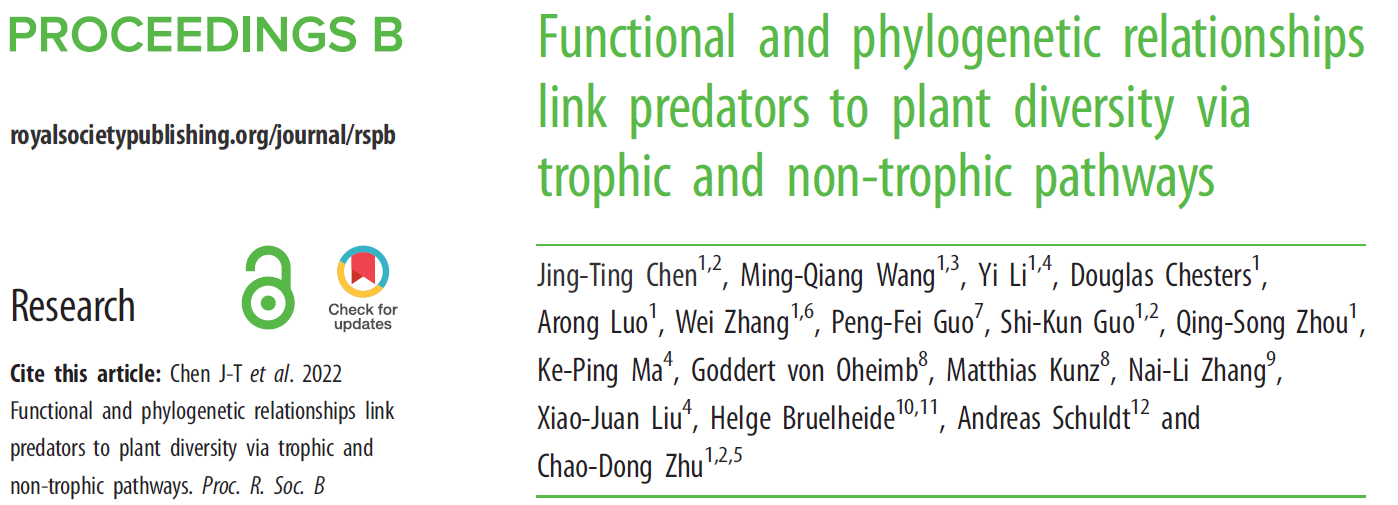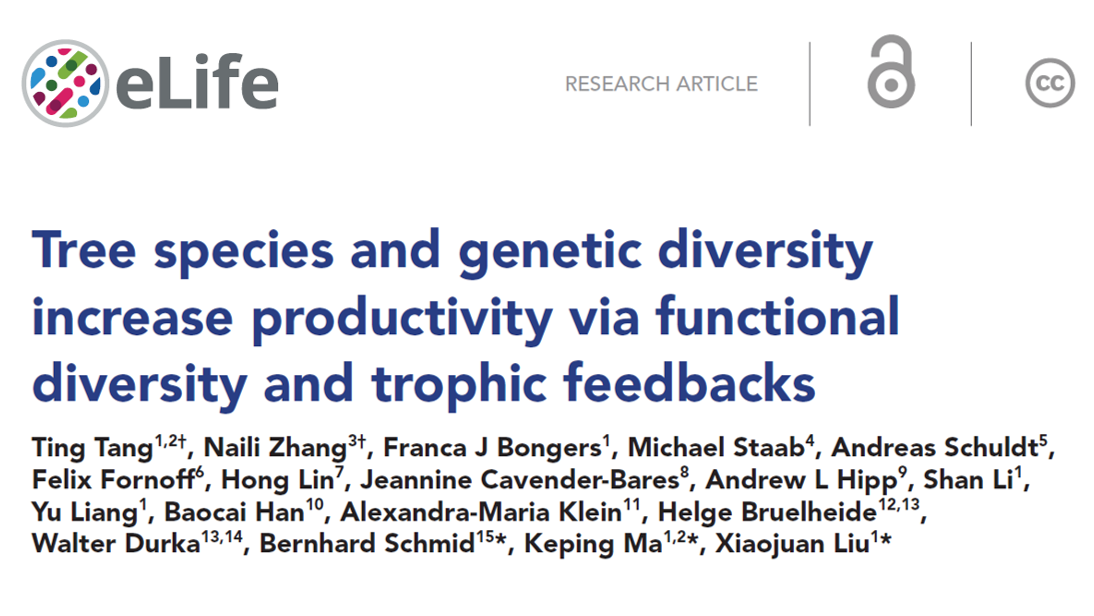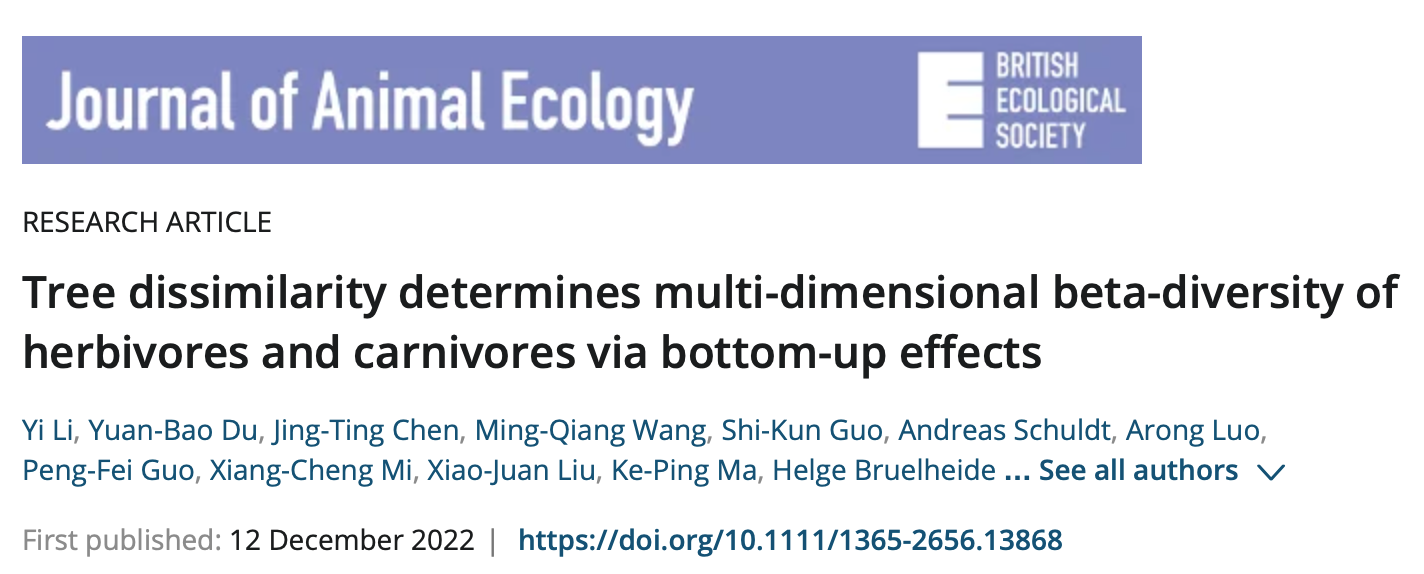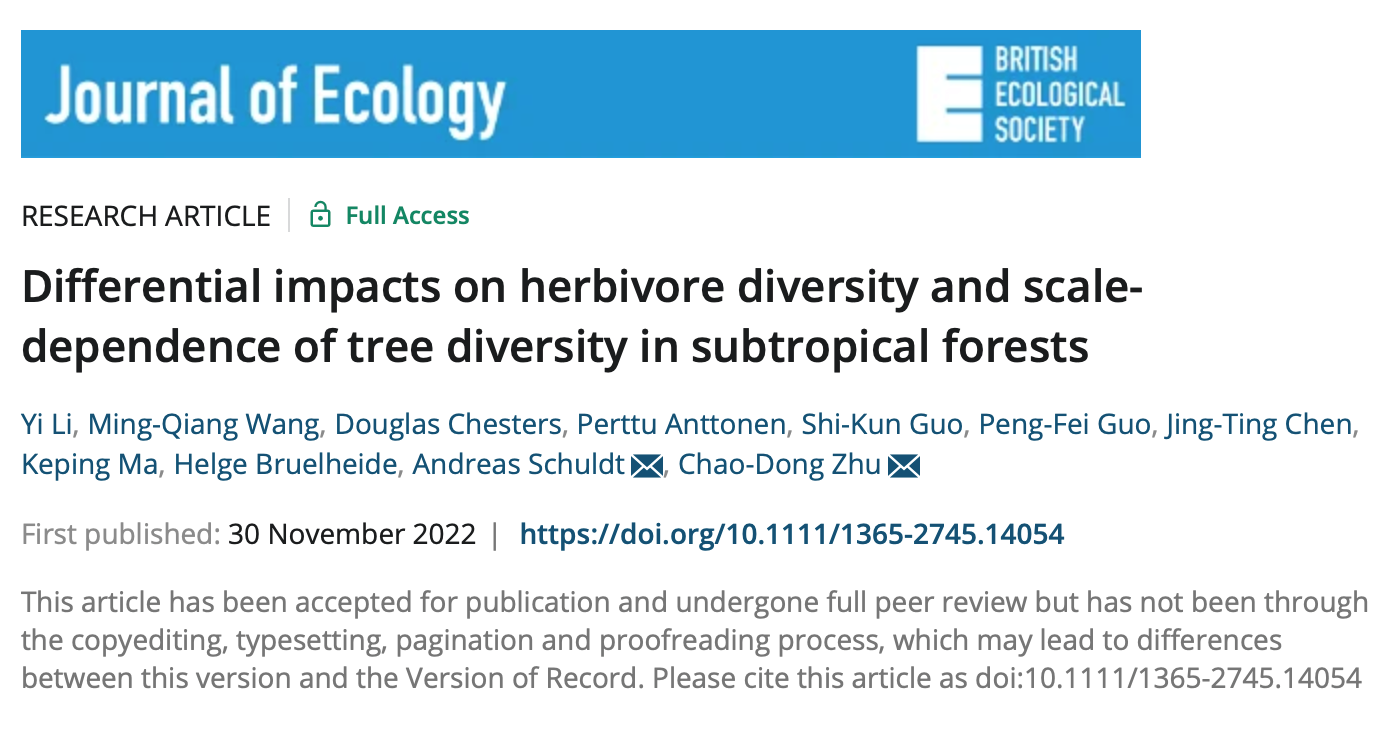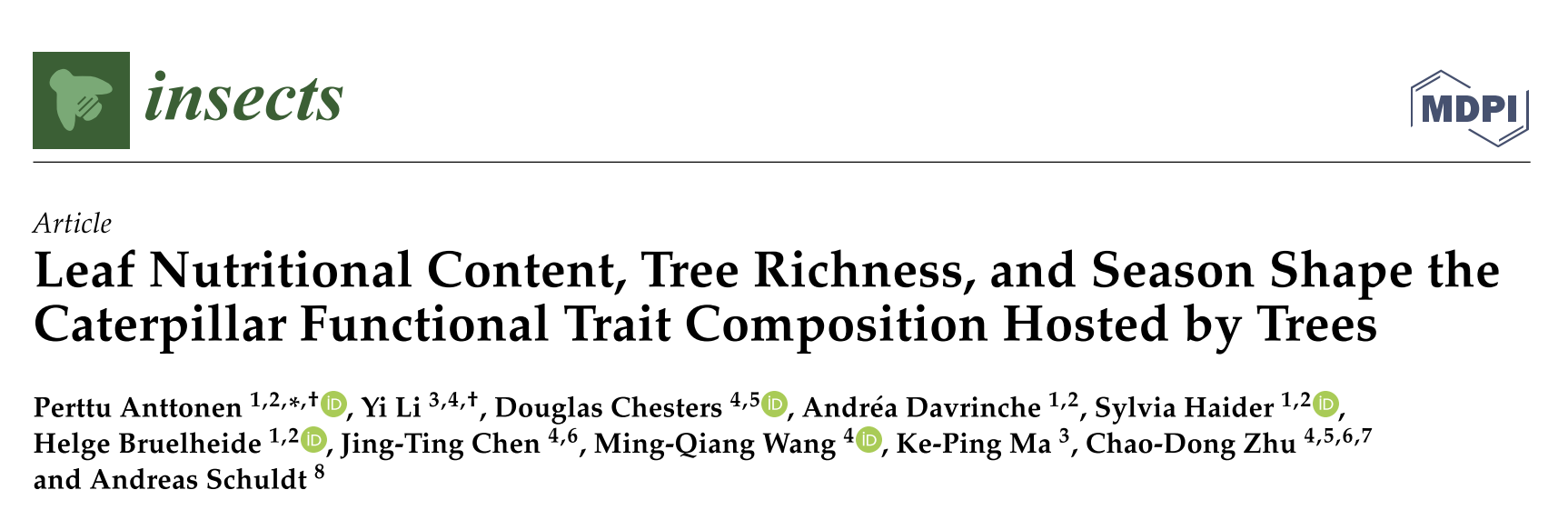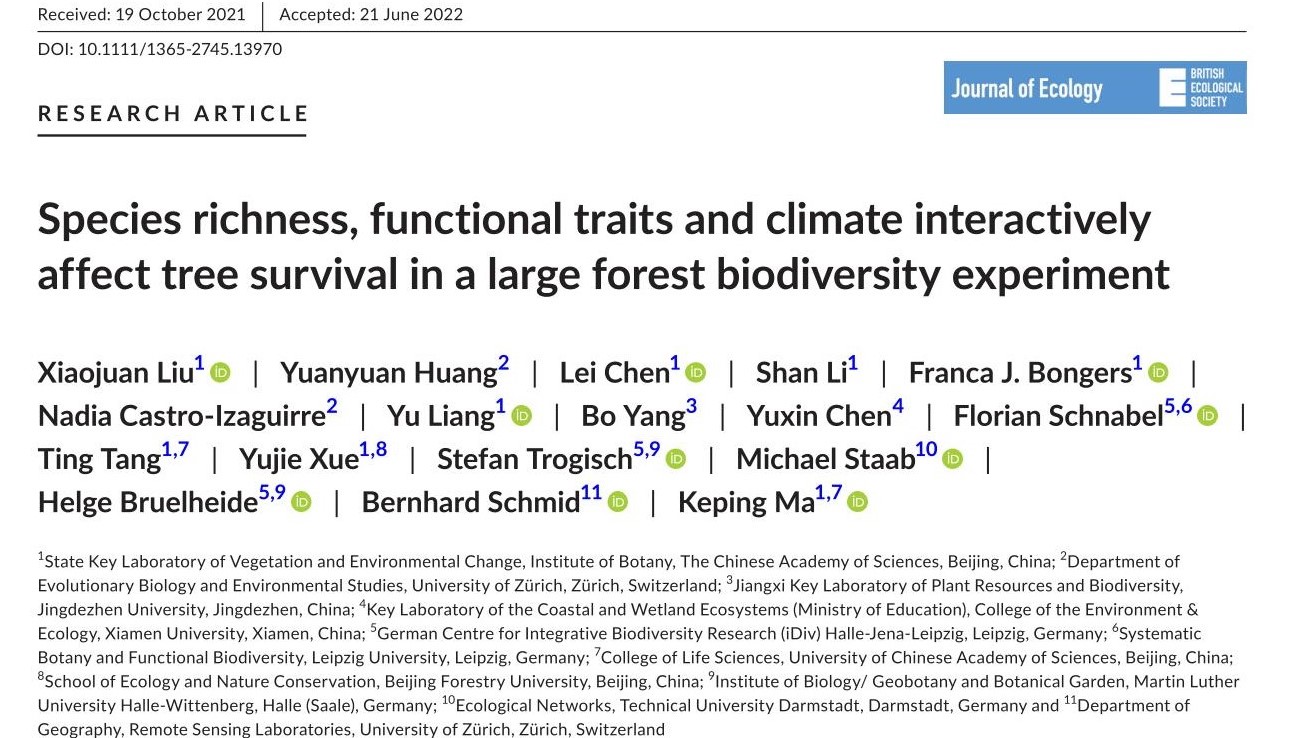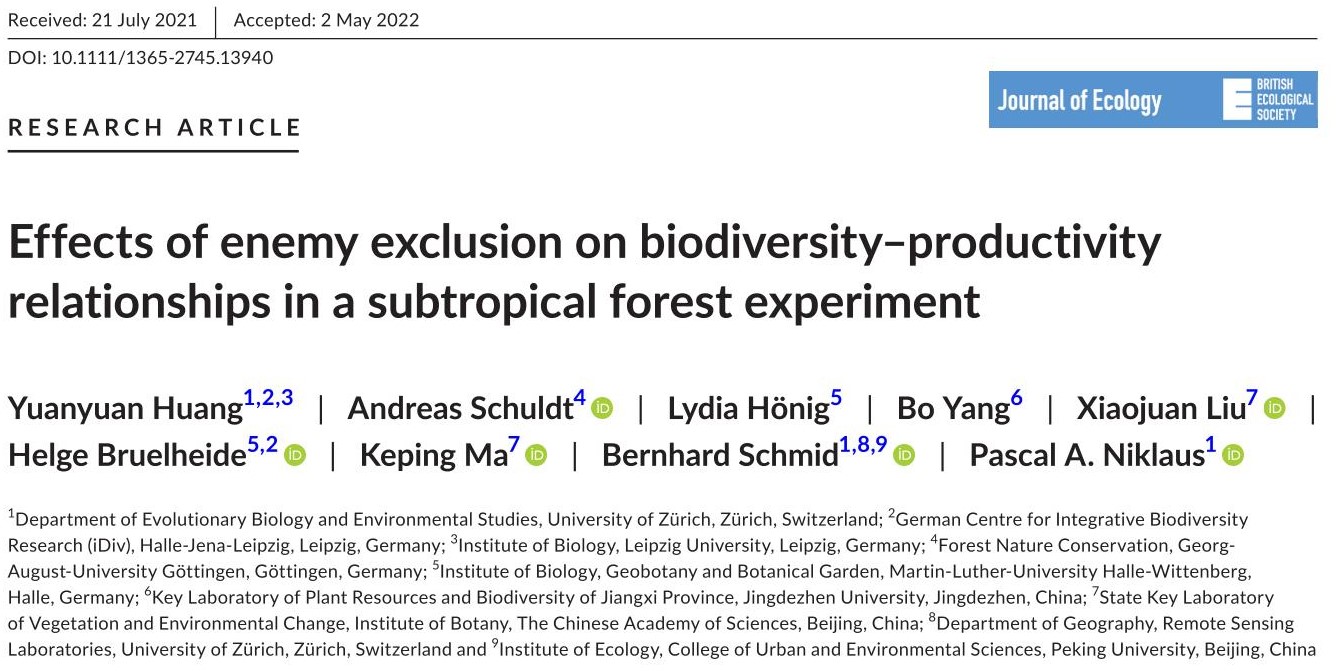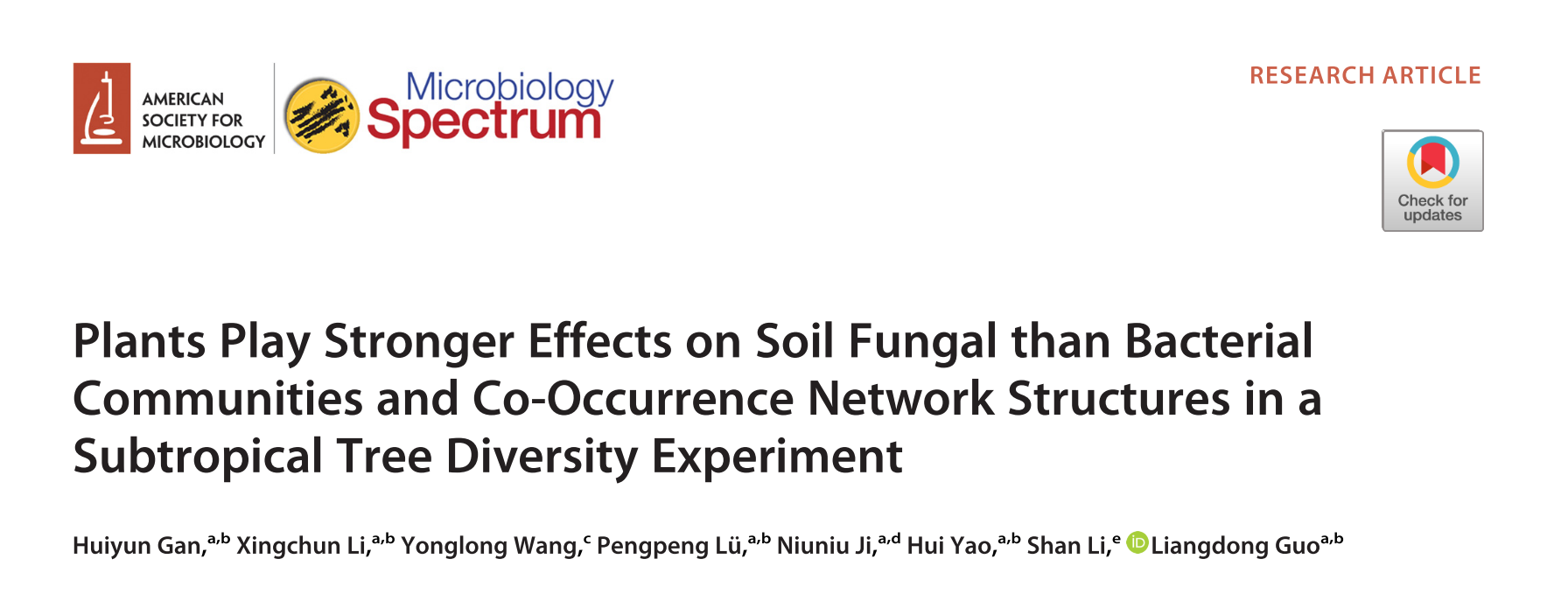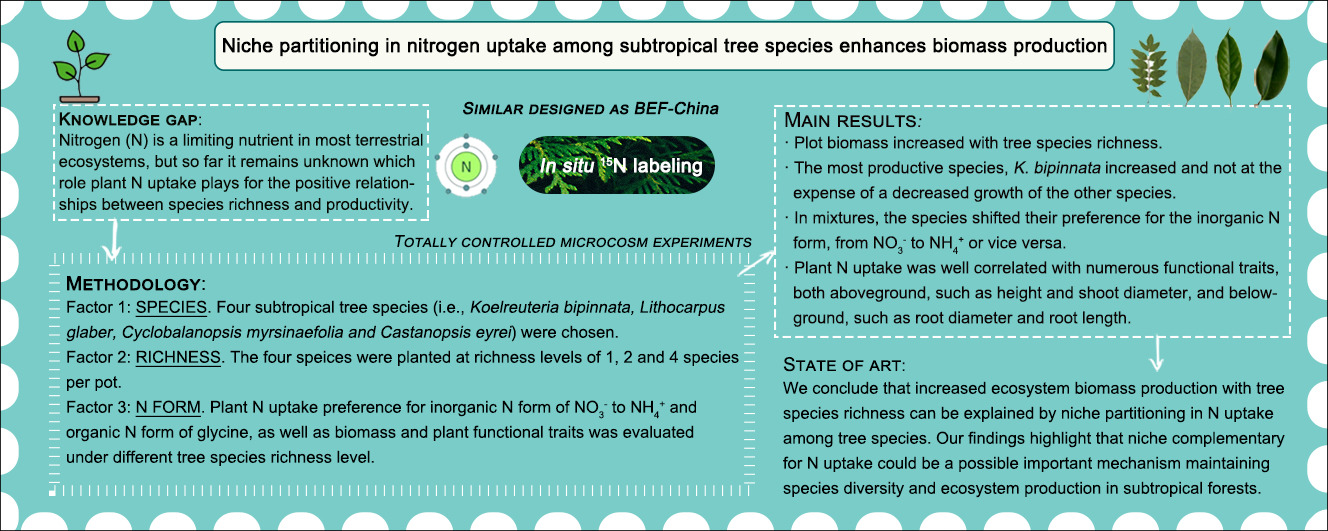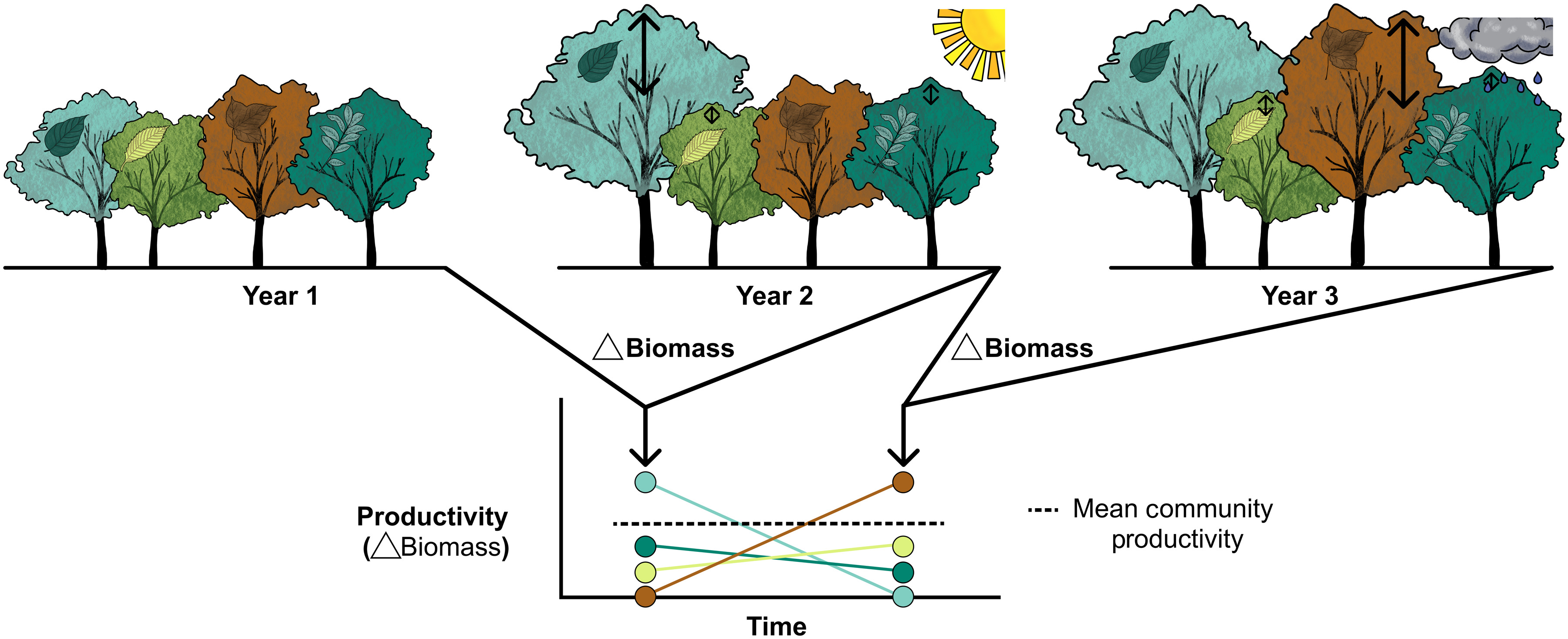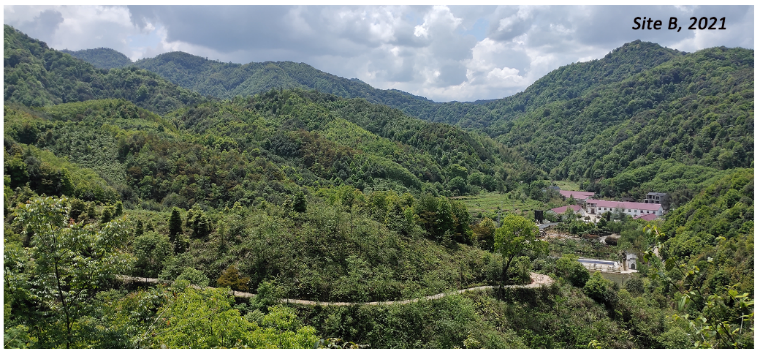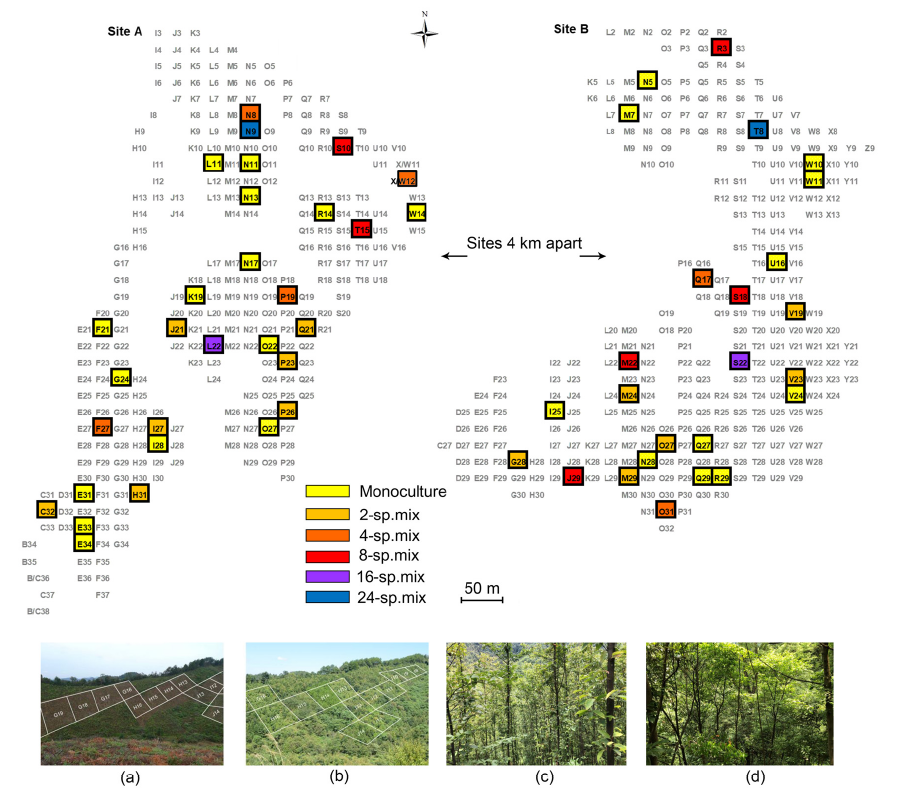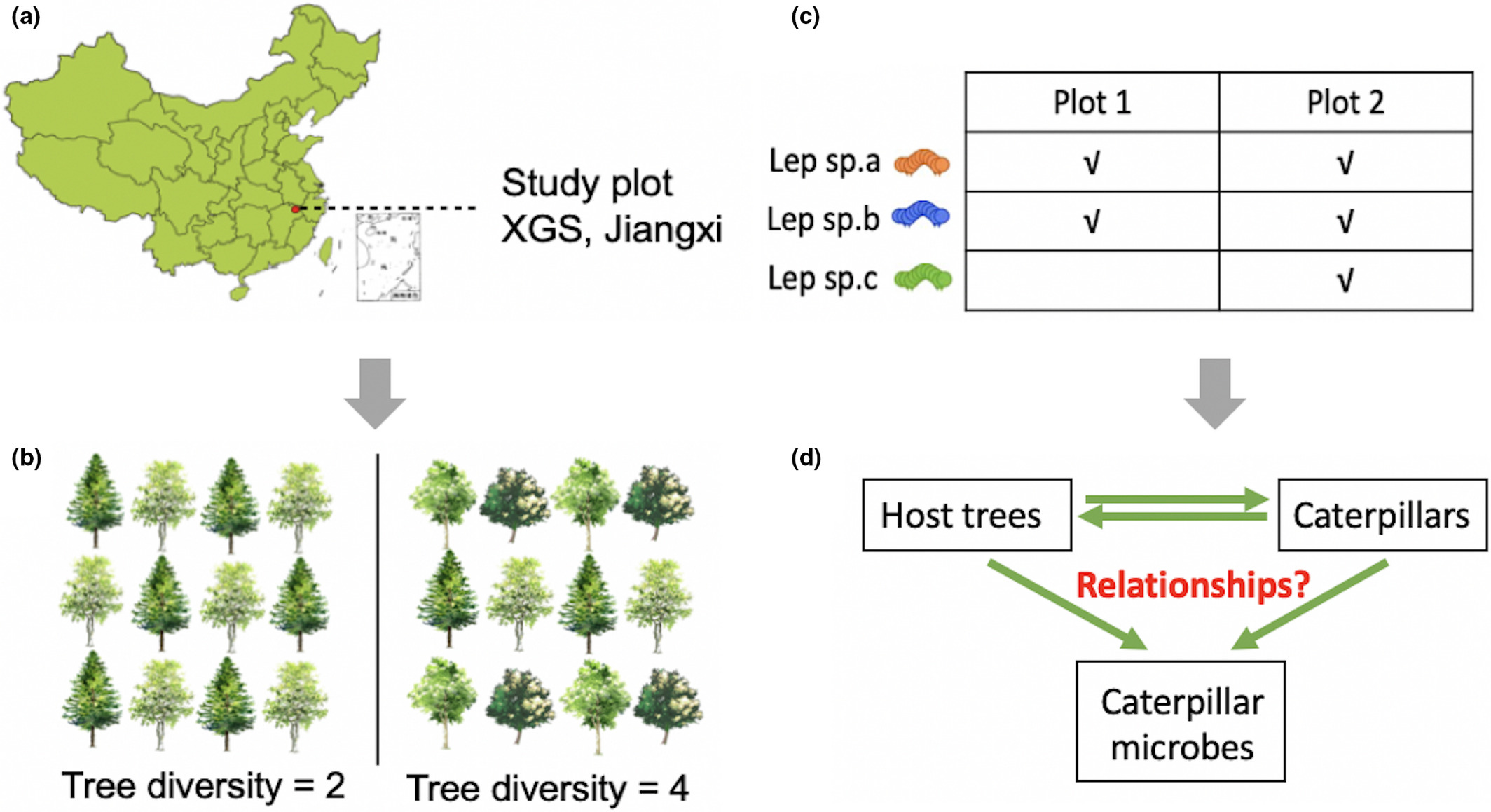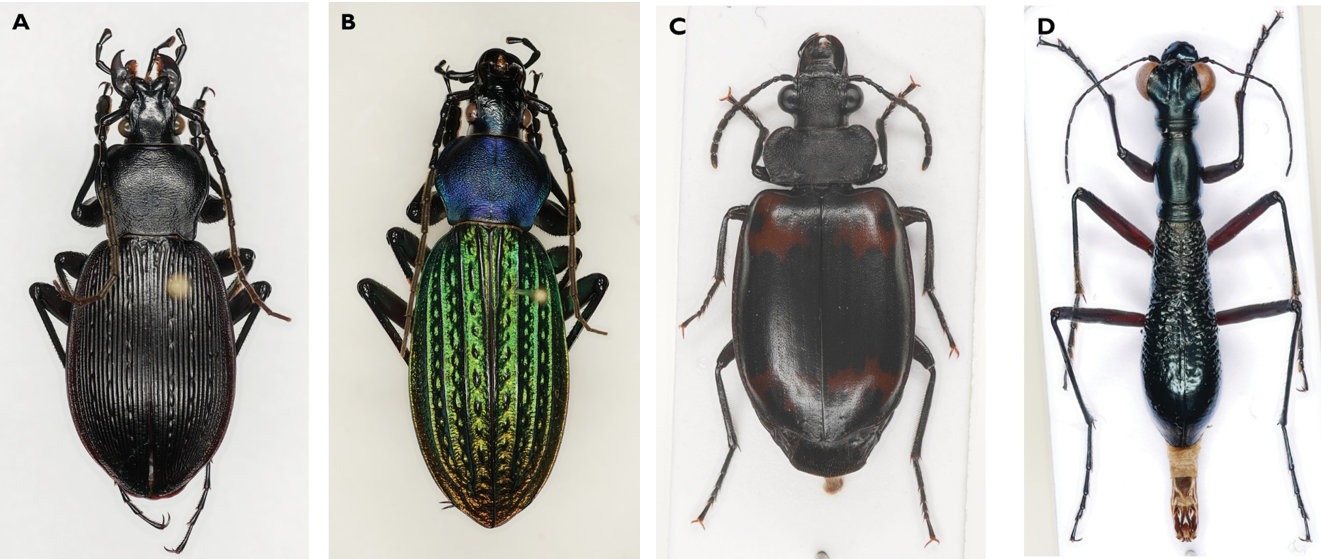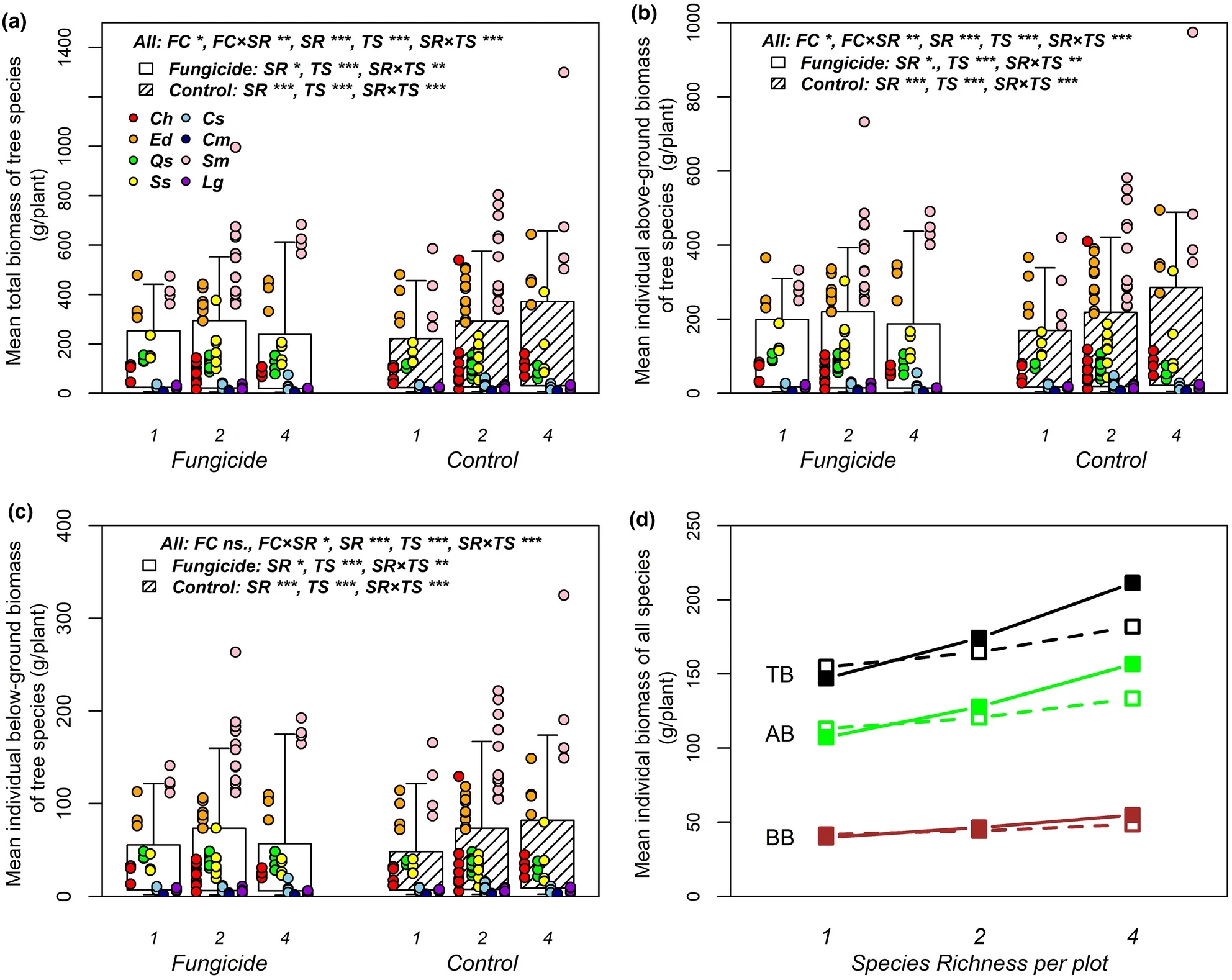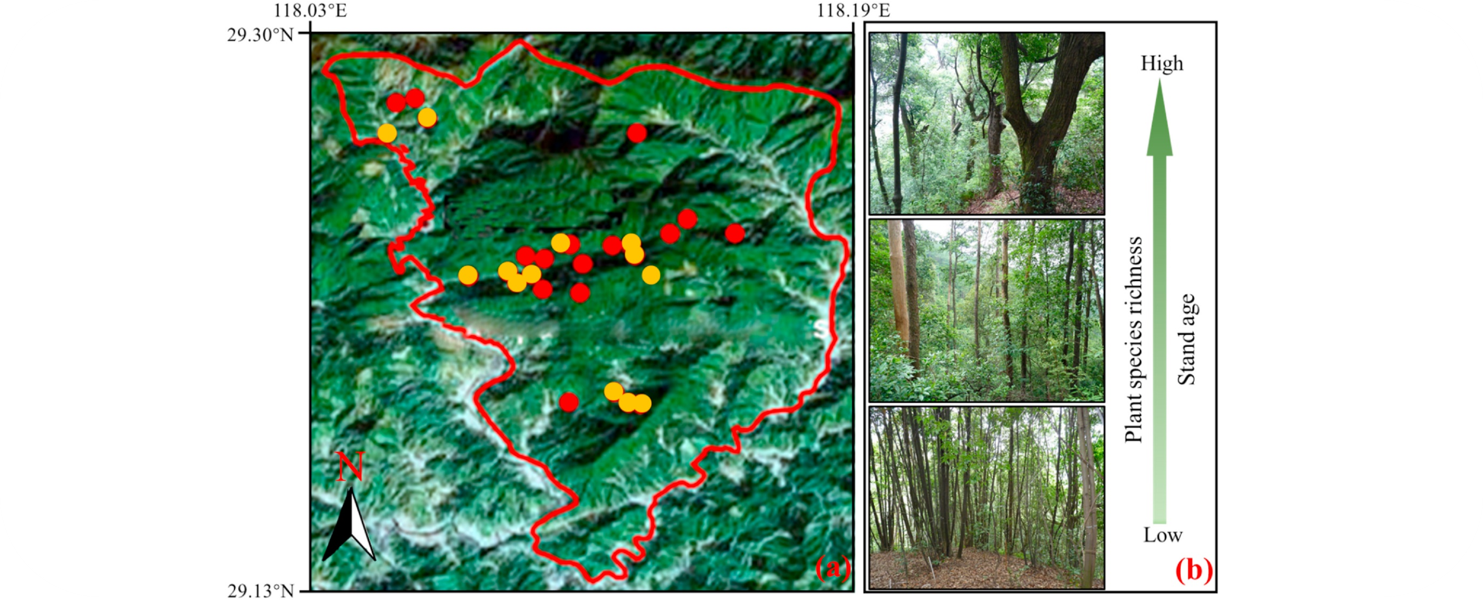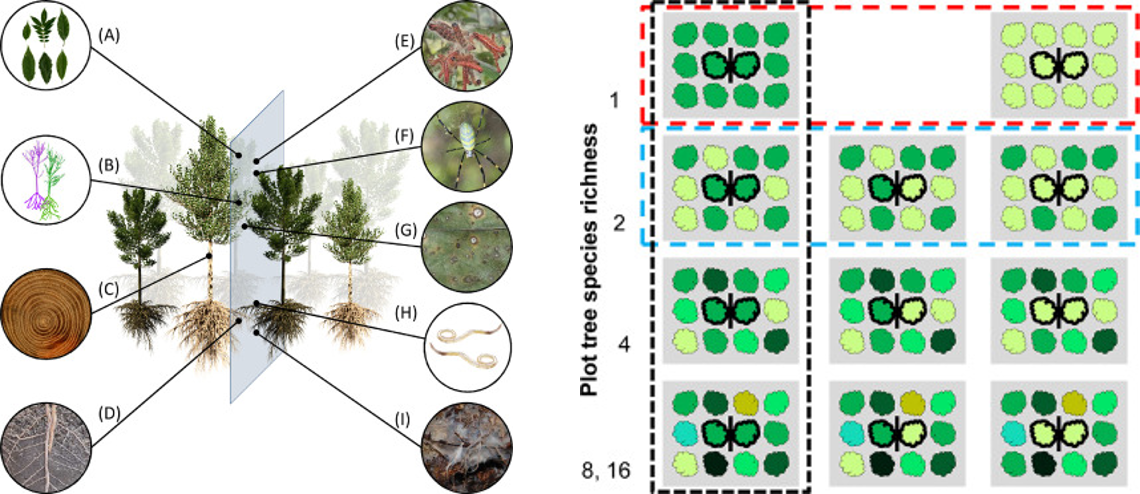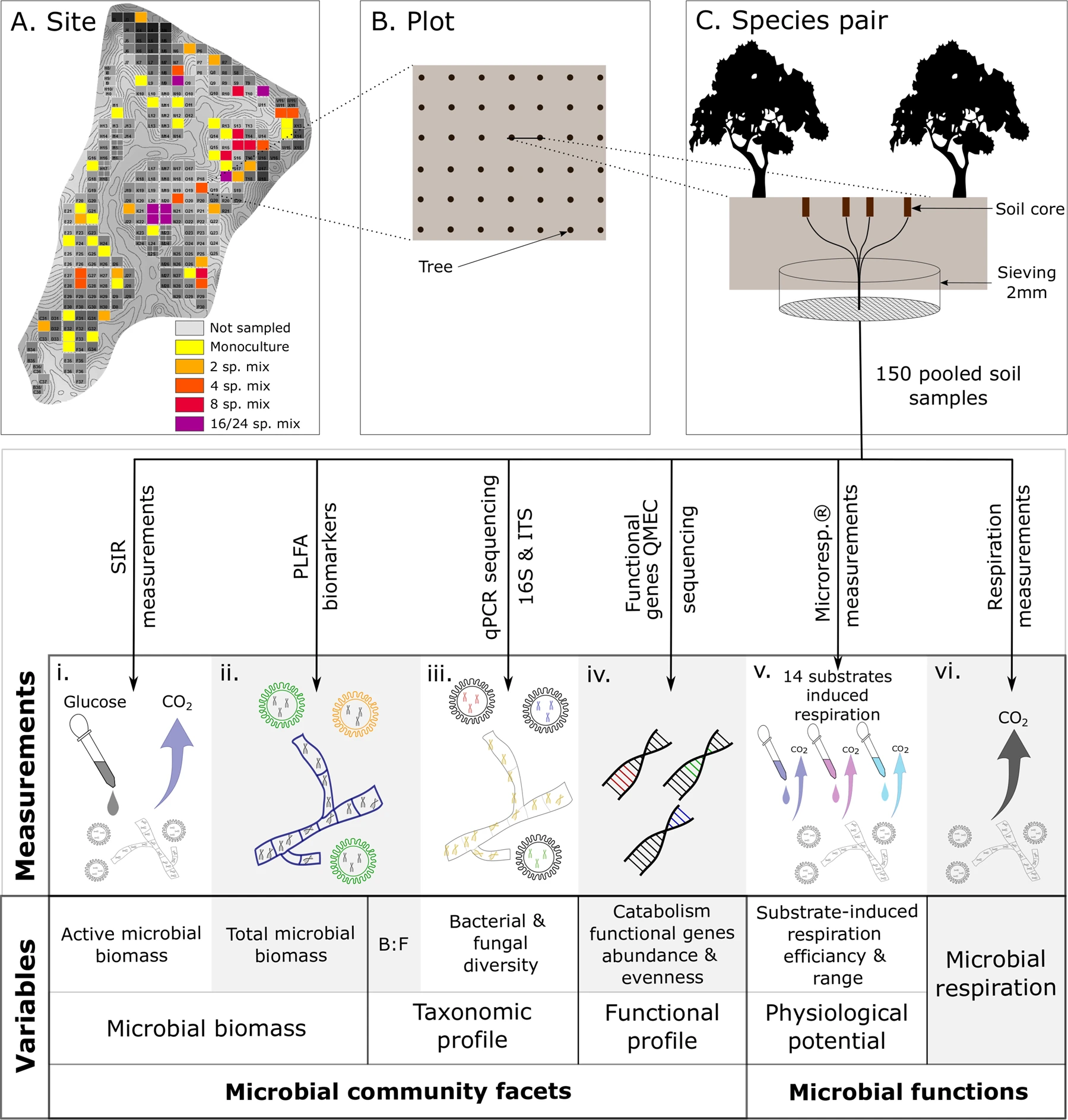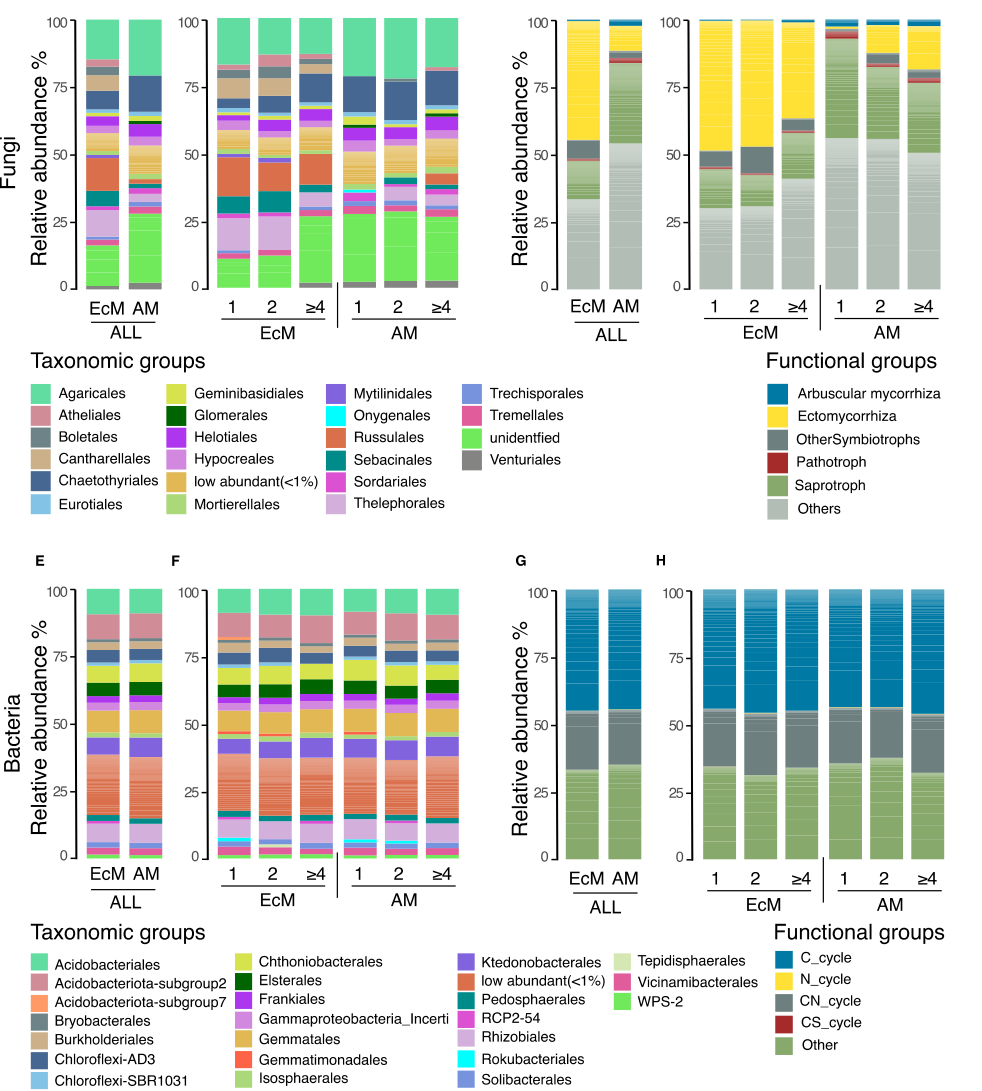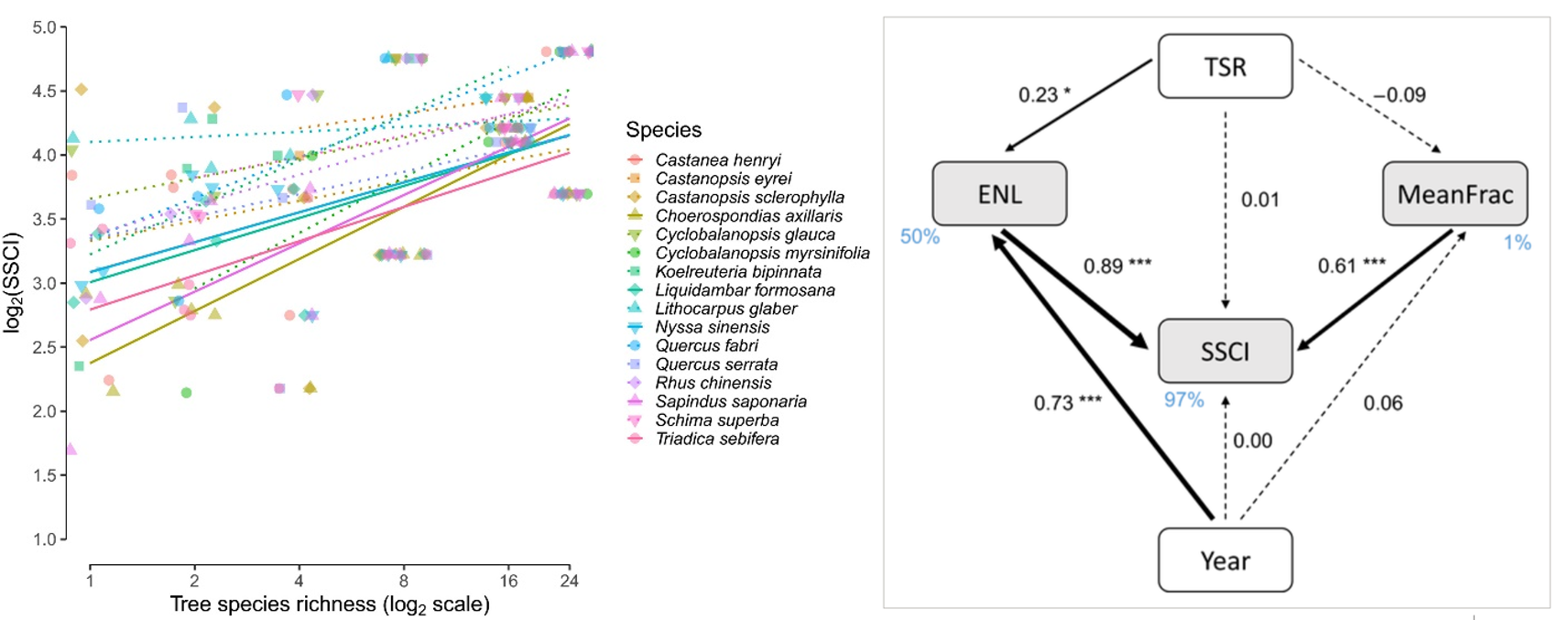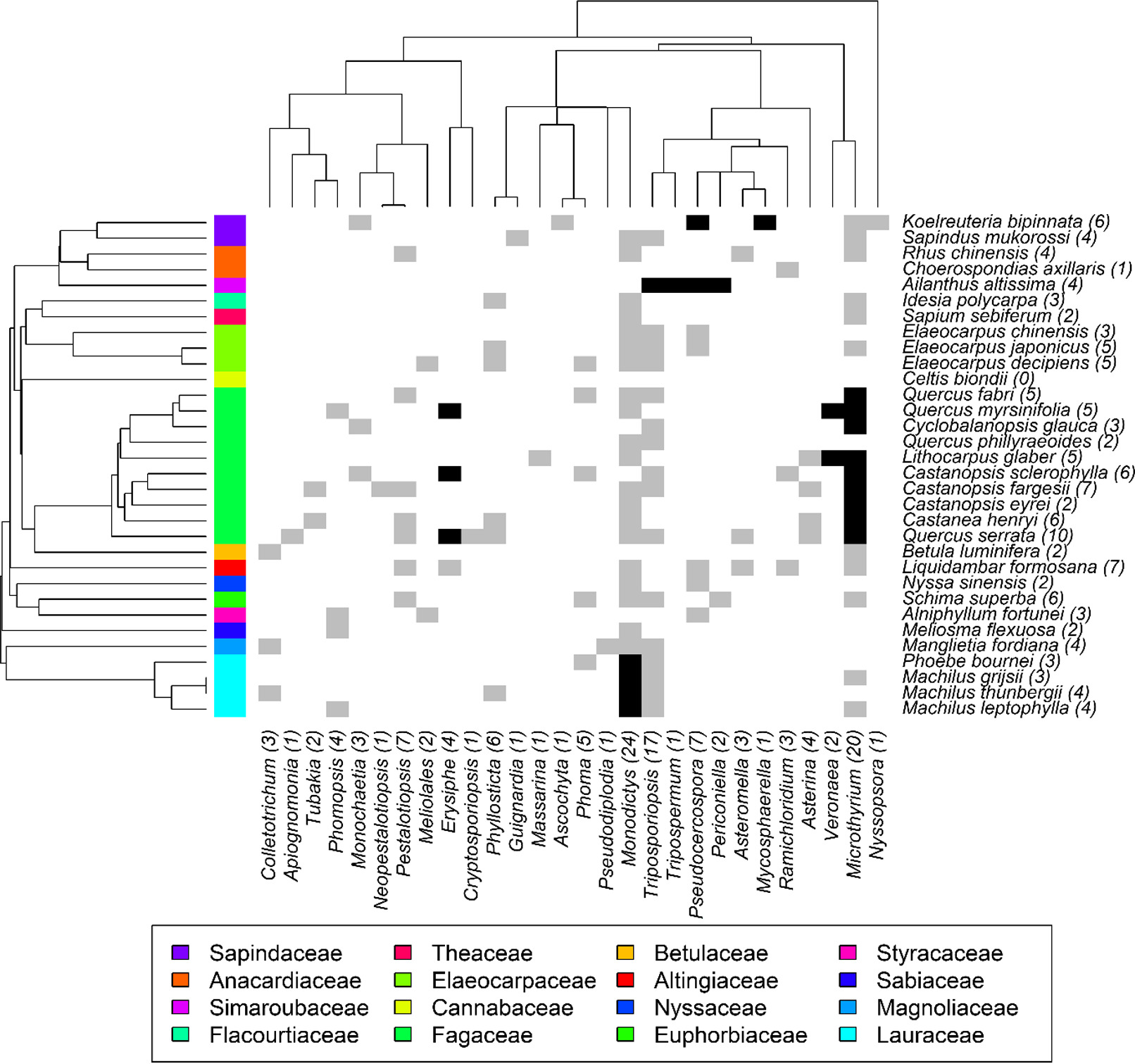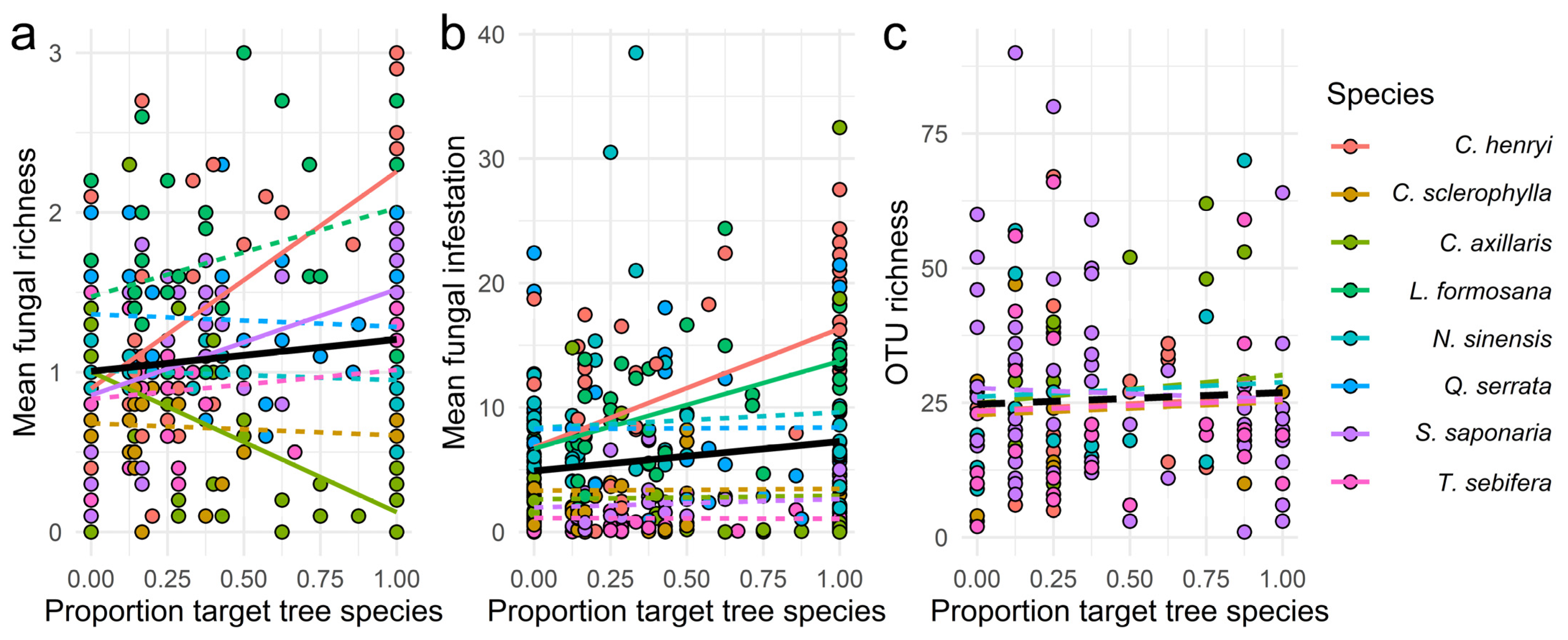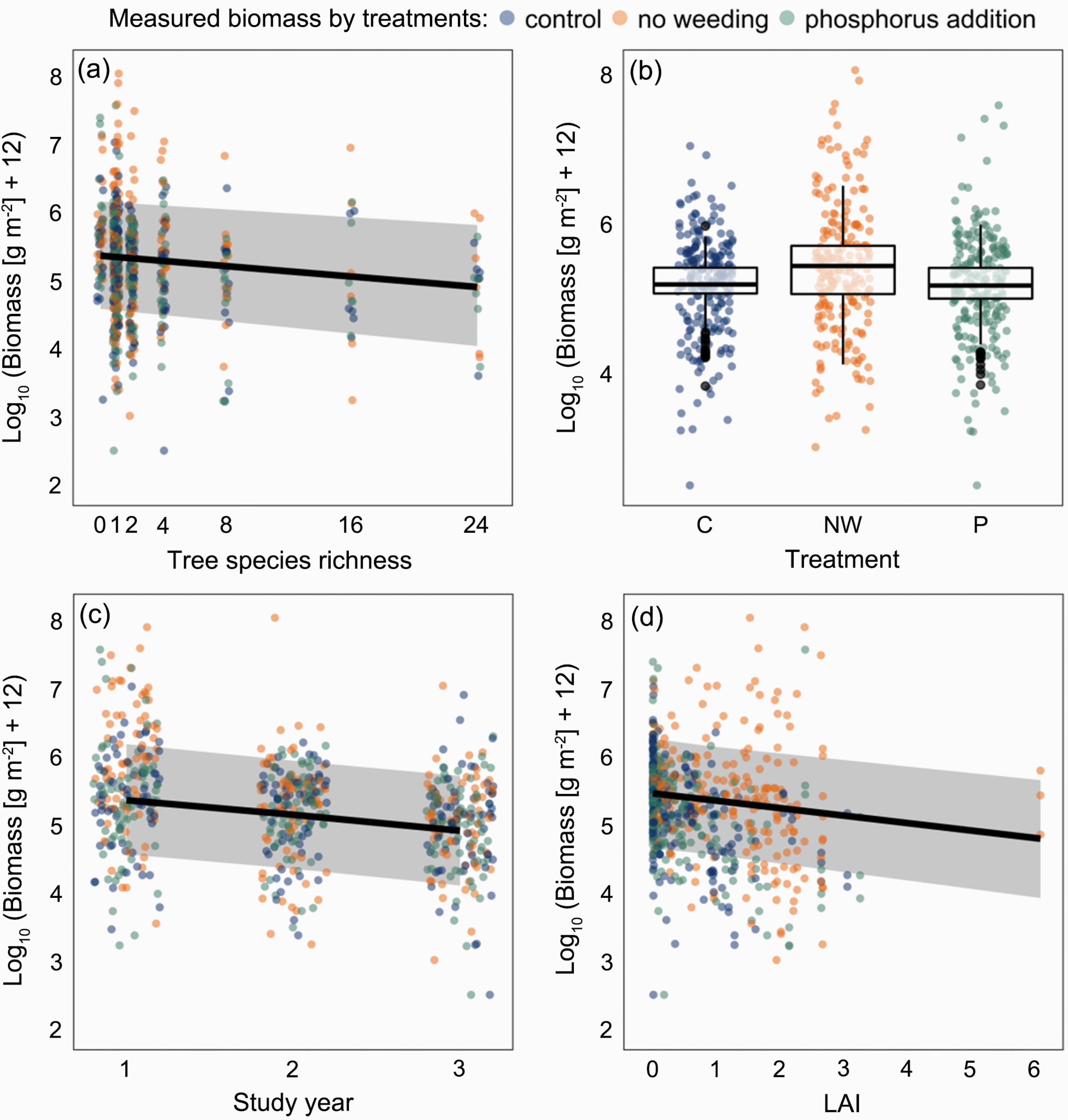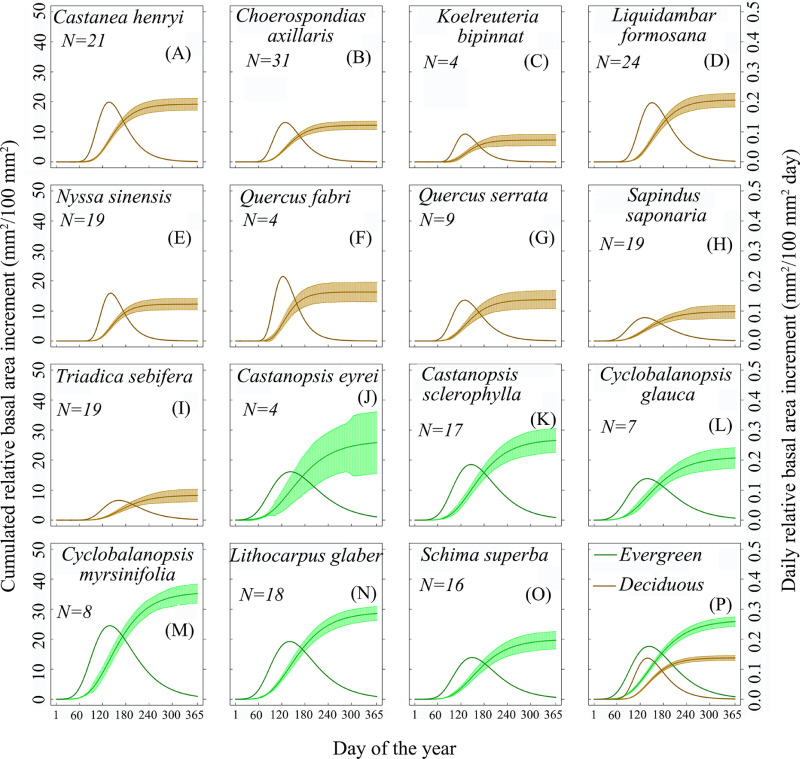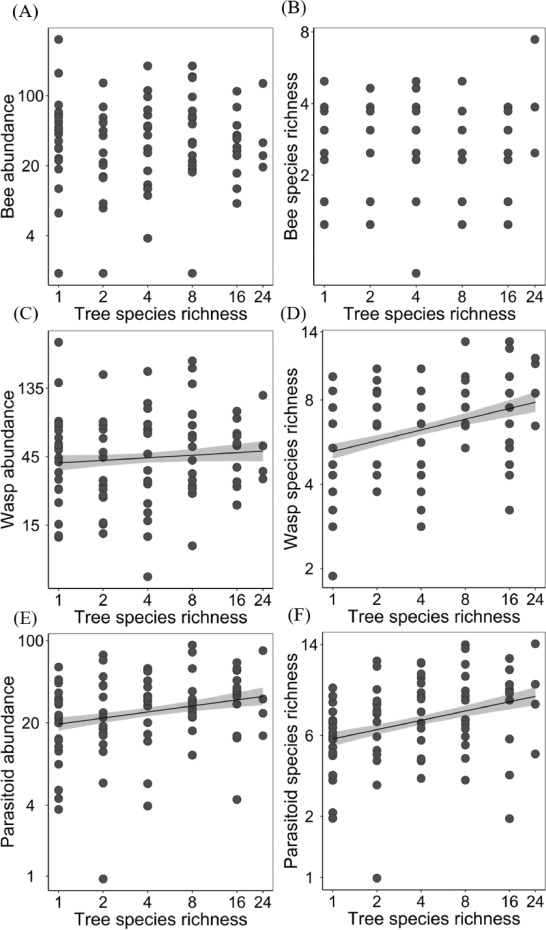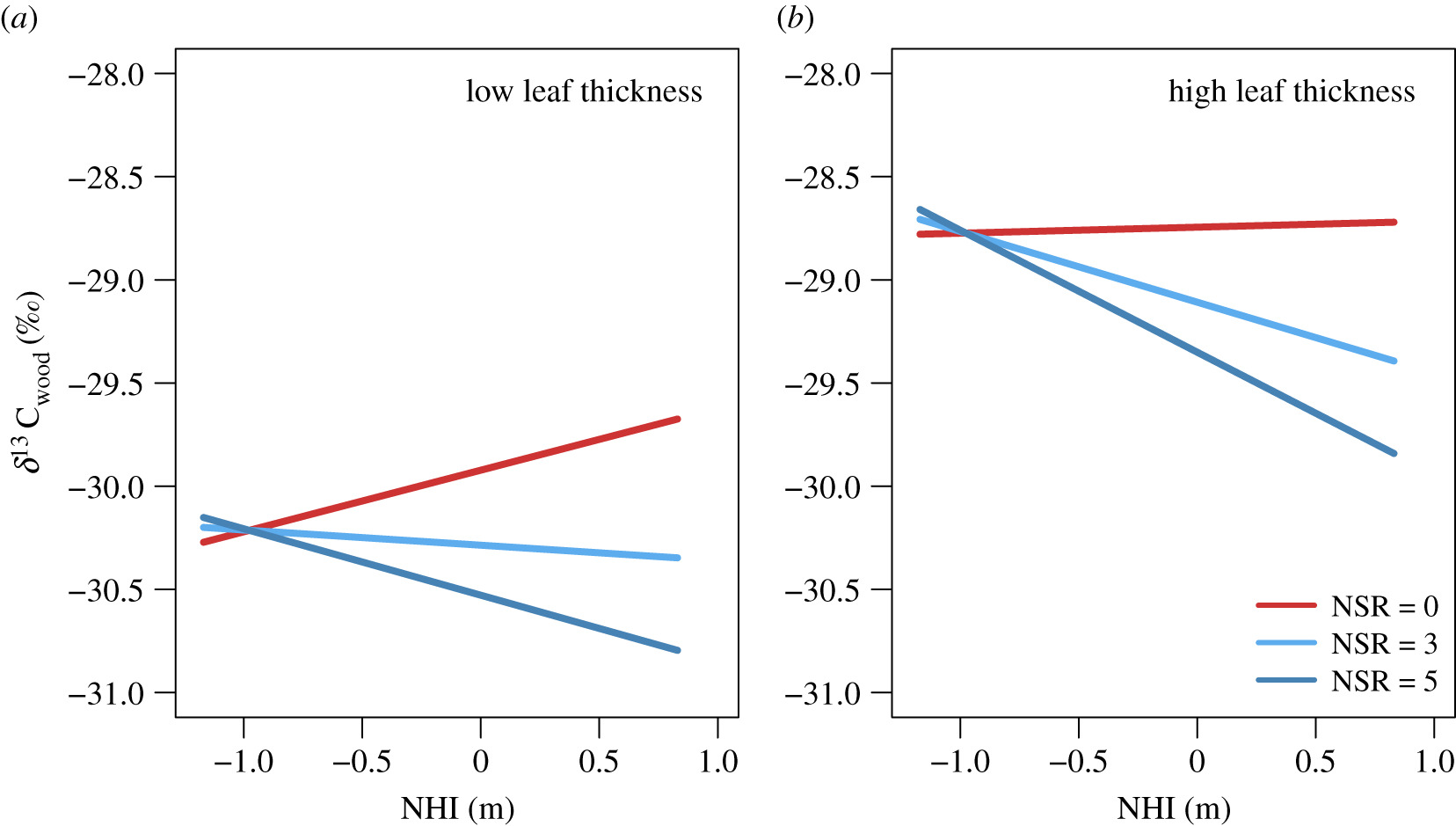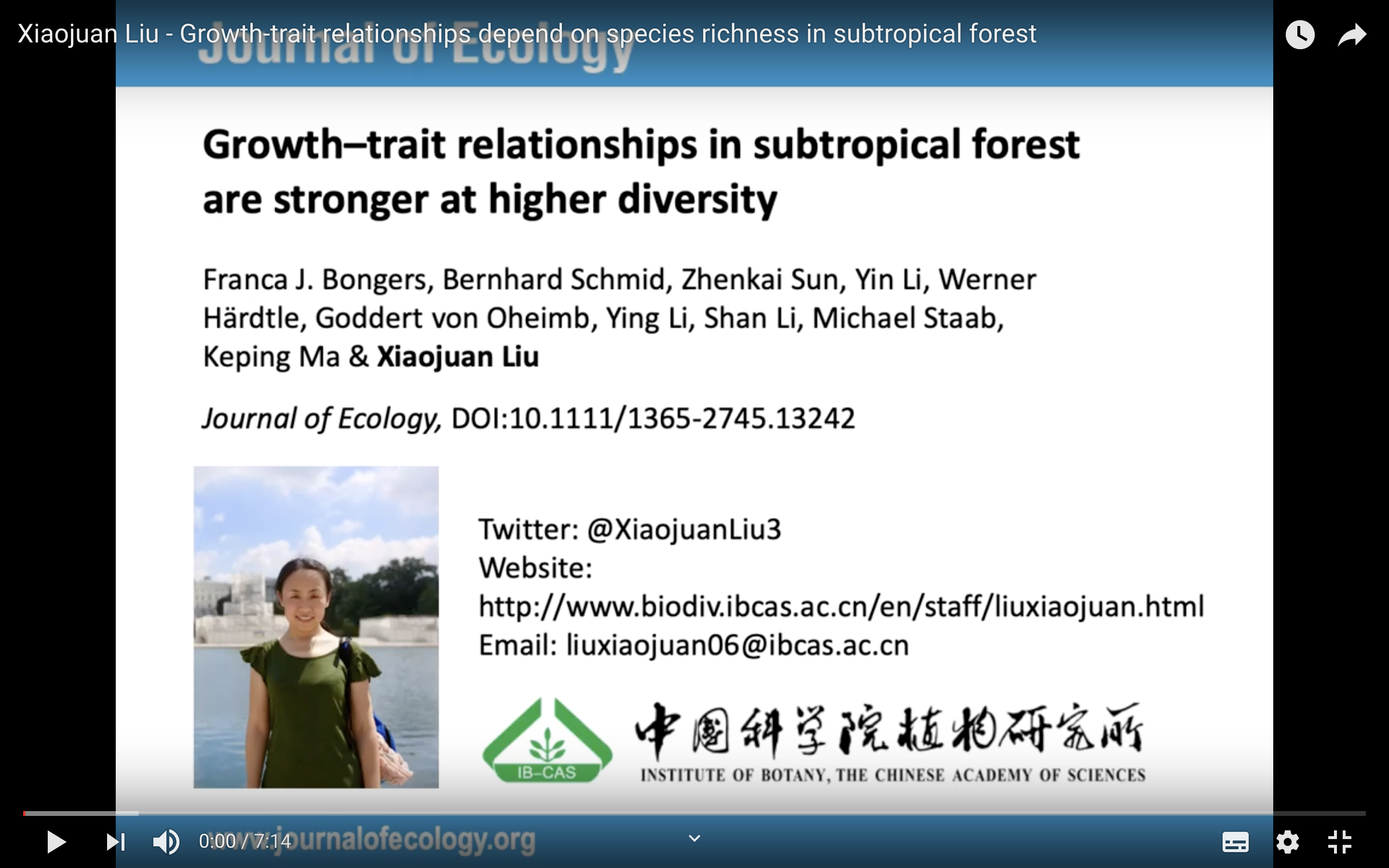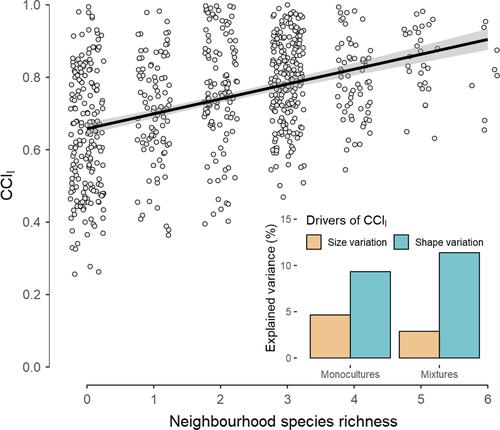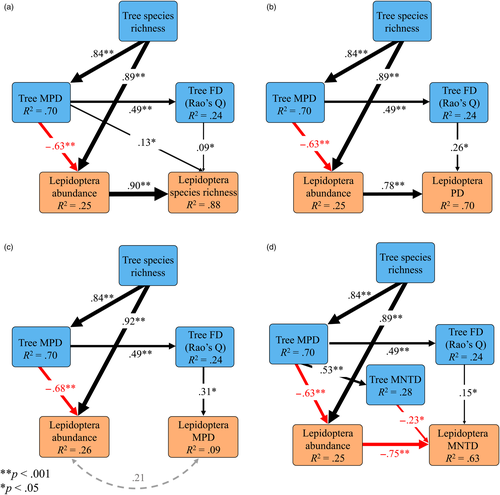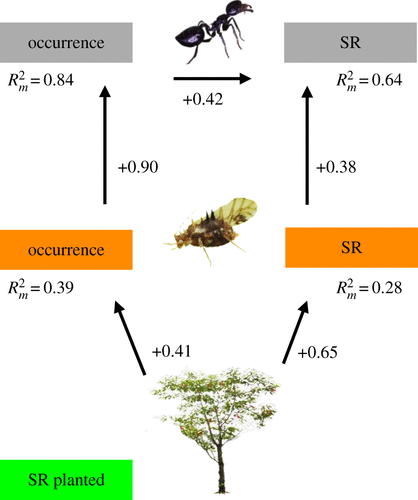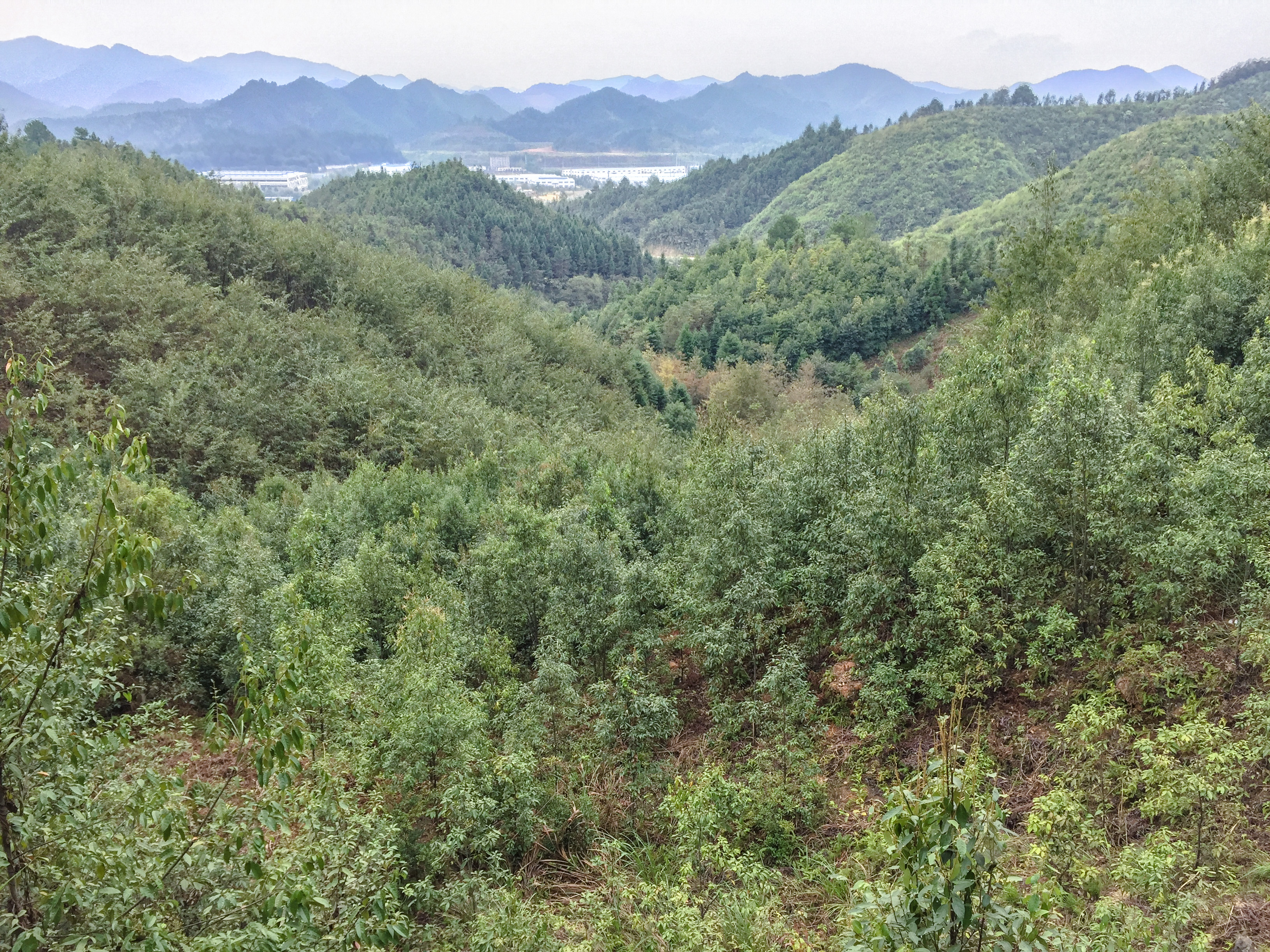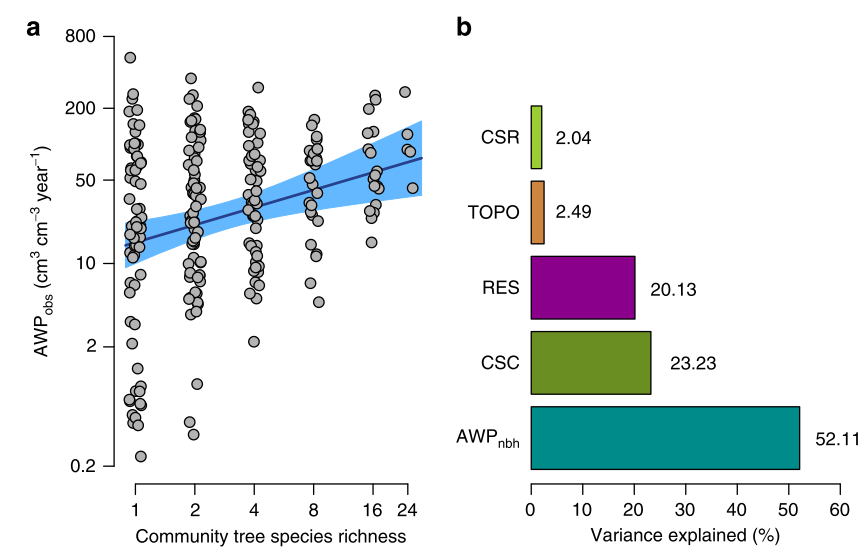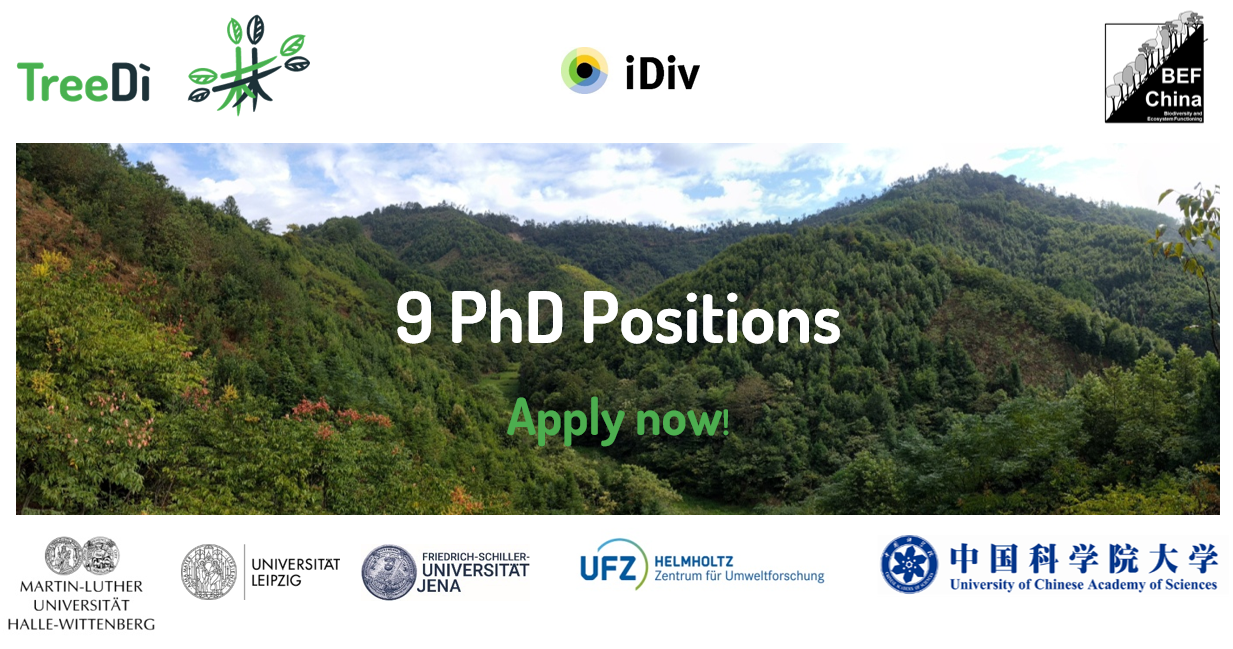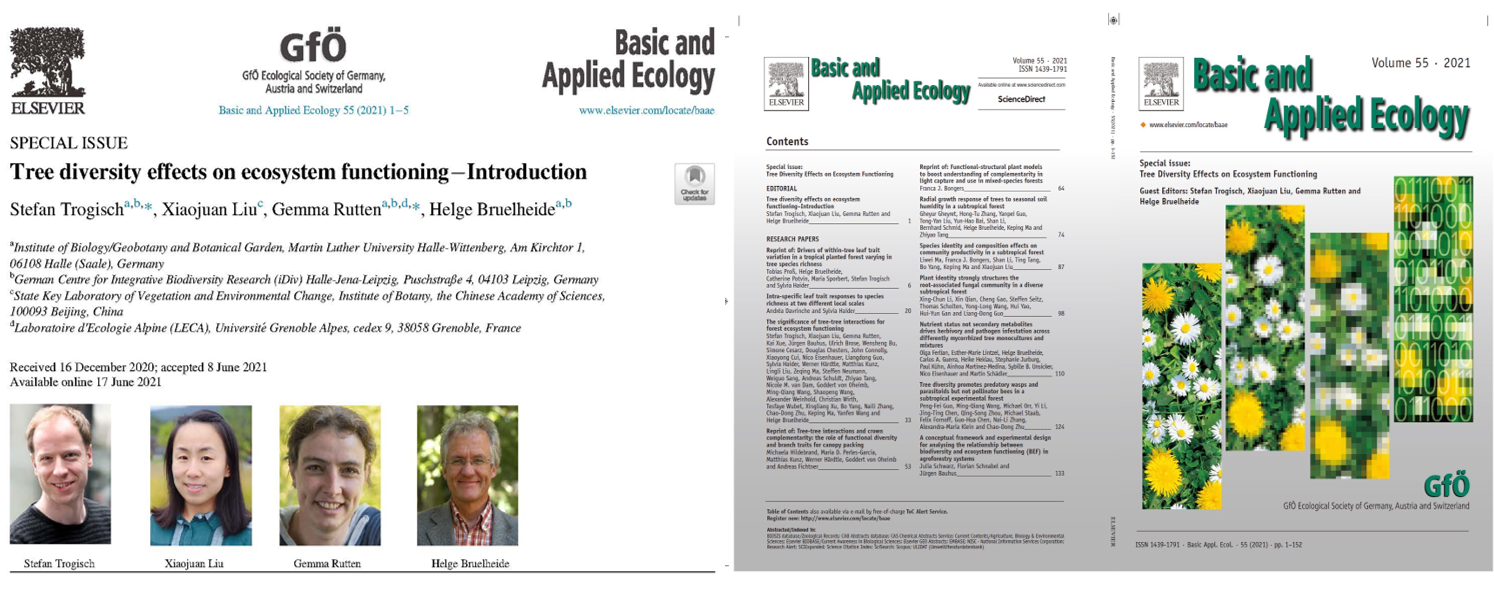Categories
publications
2025
Pablo Castro Sánchez-Bermejo*, Carlos P. Carmona, Meredith Christine Schuman, Raquel Benavides, Lena Sachsenmaier, Shan Li, Xiaojuan Liu, and Sylvia Haider. 2025. Intraspecific an...
In publications, Publications, Mar 07, 20182024
Ting-Ting Xie, Ming-Qiang Wang, Yi Li, Cheng-Yong Su, Dan Zhang, Qing-Song Zhou, Ze-Qing Niu, Feng Yuan, Xiu-Wei Liu, Ke-Ping Ma, Chao-Dong Zhu, Jia-Sheng Hao*, Douglas Chesters&a...
In publications, Publications, Mar 06, 20182023
Andreas Schuldt*, Xiaojuan Liu, Francois Buscot, Helge Bruelheide, Alexandra Erfmeier, Jinsheng He, Alexandra-Maria Klein, Keping Ma, Michael Scherer-Lorenzen, Bernhard Schmid, Th...
In publications, Publications, Mar 06, 20182023
Siqi Tao, G. F. Veen, Naili Zhang*, Tianhe Yu, Laiye Qu*. 2023. Tree and shrub richness modifies subtropical tree productivity by regulating the diversity and community compos...
In publications, Publications, Mar 05, 20182022
Ting Tang#, Naili Zhang#, Franca J. Bongers, Michael Staab, Andreas Schuldt, Felix Fornoff, Hong Lin, Jeannine Cavender-Bares, Andrew Hipp, Shan Li, Yu Liang, Baocai Han, Alexandra-Ma...
In publications, Publications, Mar 04, 20182022
Yufu Jia, Zongguang Liu, Lei Zhou, Xiaojuan Liu, Keping Ma and Xiaojuan Feng*. 2022. Soil organic carbon sourcing variance in the rhizosphere vs. non-rhizosphere of two mycorrhiza...
In publications, Publications, Mar 04, 20182021
Florian Schnabel*†, Xiaojuan Liu*†, Matthias Kunz*, Kathryn E. Barry, Franca J. Bongers, Helge Bruelheide, Andreas Fichtner, Werner Härdtle, Shan Li, Claas-Thido Pfaff, Be...
In publications, Publications, Mar 03, 20182021
Pascale Zumstein*, Helge Bruelheide, Andreas Fichtner, Andreas Schuldt, Michael Staab, Werner Hardtle, Hongzhang Zhou, and Thorsten Assmann. 2021. What shapes ground beetle assemb...
In publications, Publications, Mar 03, 20182020
Franca J. Bongers. 2020. Functional-structural plant models to boost understanding of complementarity in light capture and use in mixed-species forests. Basic and Applied Ecology. 48:...
In publications, Publications, Mar 01, 20182019
Philipp Goebes, Karsten Schmidt, Steffen Seitz*, Sabine Both, Helge Bruelheide, Alexandra Erfmeier, Thomas Scholten and Peter Kühn. 2019. The strength of soil-plant interactions u...
In publications, Publications, Feb 03, 20182019
Helge Bruelheide*, Yuxin Chen, Yuanyuan Huang, Keping Ma*, Pascal A. Niklaus* and Bernhard Schmid*. 2019. Response to Comment on “Impacts of species richness on produc...
In publications, Publications, Feb 01, 20182018
Julia Binkenstein*†, Alexandra-Maria Klein, Thorsten Assmann, François Buscot, Alexandra Erfmeier, Keping Ma, Katherina A. Pietsch, Karsten Schmidt, Thomas Scholten, Tesfaye Wubet...
In publications, Publications, Jan 02, 20182018
Huanxi Cao, Alexandra-Maria Klein, Chaodong Zhu, Michael Staab, Walter Durka, Markus Fischer and Felix Fornoff*. 2018. Intra- and interspecific tree diversity promotes multitrophi...
In publications, Publications, Jan 01, 20182017
Matteo Brezzi*, Bernhard Schmid, Pascal A. Niklaus and Andreas Schuldt. 2017. Tree diversity increases levels of herbivore damage in a subtropical forest canopy: evidence for diet...
In publications, Publications, Jan 02, 20172017
Wensheng Bu, Bernhard Schmid, Xiaojuan Liu, Ying Li, Werner Haerdtle, Goddert von Oheimb, Yu Liang, Zhenkai Sun, Yuanyuan Huang, Helge Bruelheide and Keping Ma*. 2017. Interspecif...
In publications, Publications, Jan 01, 20172016
Nadia Castro-Izaguirre*, Xiulian Chi, Martin Baruffol, Zhiyao Tang, Keping Ma, Bernhard Schmid and Pascal A Niklaus*. 2016. Tree Diversity Enhances Stand Carbon Storage but No...
In publications, Publications, Jan 02, 20162016
Uwe Braun*, Lydia Hönig and Rowena Schwaß. 2016. New records of foliicolous micromycetes from the Chinese Jiangxi Province. Schlechtendalia. 30:1-7. Download
In publications, Publications, Jan 01, 20162015
David Eichenberg*, Oliver Purschke, Christian Ristok, Ludger Wessjohann and Helge Bruelheide. 2015. Trade-offs between physical and chemical carbon-based leaf defence: of intraspe...
In publications, Publications, May 02, 20102015
Uwe Braun*, Steffen Bien, Lydia Hönig and Bettina Heuchert. 2015. Periconiella liquidambaricola sp nov - a new Chinese hyphomycete. Mycotaxon. 130:253-258. https://doi.org/10.5248...
In publications, Publications, May 01, 20102014
Martin Böhnke, Wenzel Kröber, Erik Welk, Christian Wirth and Helge Bruelheide*. 2014. Maintenance of constant functional diversity during secondary succession of a subtropical for...
In publications, Publications, Apr 02, 20102014
Uwe Braun*, Steffen Bien, Lydia Hantsch and Bettina Heuchert. 2014. Tubakia chinensis sp. nov. and a key to the species of the genus Tubakia. Schlechtendalia. 28:23-28. Download
In publications, Publications, Apr 01, 20102013
Martin Barrufol, Bernhard Schmid, Helge Bruelheide, Xiulian Chi, Andrew Hector, Keping Ma, Stefan Michalski, Zhiyao Tang and Pascal A. Niklaus*. 2013. Biodiversity Promotes Tree G...
In publications, Publications, Mar 02, 20102013
Yinlei Ma, Yan Geng, Yuanyuan Huang, Yue Shi, Pascal A. Niklaus, Bernhard Schmid and Jinsheng He*. 2013. Effect of clear-cutting silviculture on soil respiration in a subtropical ...
In publications, Publications, Mar 01, 20102012
Dörte Bachmann*, Sabine Both, Helge Bruelheide, Bingyang Ding, Mo Gao, Werner Härdtle, Michael Scherer-Lorenzen and Alexandra Erfmeier. 2012. Functional trait similarity of native...
In publications, Publications, Feb 02, 20102012
Sabine Both*, Teng Fang, Martin Baruffol, Bernhard Schmid, Helge Bruelheide and Alexandra Erfmeier. 2012. Effects of tree sapling diversity and nutrient addition on herb-layer inv...
In publications, Publications, Feb 01, 20102011
Sabine Both*, Teng Fang, Martin Böhnke, Helge Bruelheide, Christian Geißler, Peter Kühn, Thomas Scholten, Stefan Trogisch and Alexandra Erfmeier. 2011. Lack of tree layer control ...
In publications, Publications, Jan 24, 20102011
Helge Bruelheide*, Martin Böhnke, Sabine Both, Teng Fang, Thorsten Assmann, Martin Baruffol, Jürgen Bauhus, François Buscot, Xiaoyong Chen, Bingyang Ding, Walter Durka, Alexandra ...
In publications, Publications, Jan 23, 20102010
Christian Geißler*, Peter Kühn, Xuezheng Shi and Thomas Scholten. 2010. Estimation of throughfall erosivity in a highly diverse forest ecosystem using sand-filled splash cups. Jou...
In publications, Publications, Jan 02, 2010Publications
2025
Pablo Castro Sánchez-Bermejo*, Carlos P. Carmona, Meredith Christine Schuman, Raquel Benavides, Lena Sachsenmaier, Shan Li, Xiaojuan Liu, and Sylvia Haider. 2025. Intraspecific an...
In publications, Publications, Mar 07, 20182024
Ting-Ting Xie, Ming-Qiang Wang, Yi Li, Cheng-Yong Su, Dan Zhang, Qing-Song Zhou, Ze-Qing Niu, Feng Yuan, Xiu-Wei Liu, Ke-Ping Ma, Chao-Dong Zhu, Jia-Sheng Hao*, Douglas Chesters&a...
In publications, Publications, Mar 06, 20182023
Andreas Schuldt*, Xiaojuan Liu, Francois Buscot, Helge Bruelheide, Alexandra Erfmeier, Jinsheng He, Alexandra-Maria Klein, Keping Ma, Michael Scherer-Lorenzen, Bernhard Schmid, Th...
In publications, Publications, Mar 06, 20182023
Siqi Tao, G. F. Veen, Naili Zhang*, Tianhe Yu, Laiye Qu*. 2023. Tree and shrub richness modifies subtropical tree productivity by regulating the diversity and community compos...
In publications, Publications, Mar 05, 20182022
Ting Tang#, Naili Zhang#, Franca J. Bongers, Michael Staab, Andreas Schuldt, Felix Fornoff, Hong Lin, Jeannine Cavender-Bares, Andrew Hipp, Shan Li, Yu Liang, Baocai Han, Alexandra-Ma...
In publications, Publications, Mar 04, 20182022
Yufu Jia, Zongguang Liu, Lei Zhou, Xiaojuan Liu, Keping Ma and Xiaojuan Feng*. 2022. Soil organic carbon sourcing variance in the rhizosphere vs. non-rhizosphere of two mycorrhiza...
In publications, Publications, Mar 04, 20182021
Florian Schnabel*†, Xiaojuan Liu*†, Matthias Kunz*, Kathryn E. Barry, Franca J. Bongers, Helge Bruelheide, Andreas Fichtner, Werner Härdtle, Shan Li, Claas-Thido Pfaff, Be...
In publications, Publications, Mar 03, 20182021
Pascale Zumstein*, Helge Bruelheide, Andreas Fichtner, Andreas Schuldt, Michael Staab, Werner Hardtle, Hongzhang Zhou, and Thorsten Assmann. 2021. What shapes ground beetle assemb...
In publications, Publications, Mar 03, 20182020
Franca J. Bongers. 2020. Functional-structural plant models to boost understanding of complementarity in light capture and use in mixed-species forests. Basic and Applied Ecology. 48:...
In publications, Publications, Mar 01, 20182019
Philipp Goebes, Karsten Schmidt, Steffen Seitz*, Sabine Both, Helge Bruelheide, Alexandra Erfmeier, Thomas Scholten and Peter Kühn. 2019. The strength of soil-plant interactions u...
In publications, Publications, Feb 03, 20182019
Helge Bruelheide*, Yuxin Chen, Yuanyuan Huang, Keping Ma*, Pascal A. Niklaus* and Bernhard Schmid*. 2019. Response to Comment on “Impacts of species richness on produc...
In publications, Publications, Feb 01, 2018Ongoing projects
If you wish to apply for a new project in BEF-China, please download the application form.
In projects, Publications, Jan 15, 20182018
Julia Binkenstein*†, Alexandra-Maria Klein, Thorsten Assmann, François Buscot, Alexandra Erfmeier, Keping Ma, Katherina A. Pietsch, Karsten Schmidt, Thomas Scholten, Tesfaye Wubet...
In publications, Publications, Jan 02, 20182018
Huanxi Cao, Alexandra-Maria Klein, Chaodong Zhu, Michael Staab, Walter Durka, Markus Fischer and Felix Fornoff*. 2018. Intra- and interspecific tree diversity promotes multitrophi...
In publications, Publications, Jan 01, 20182017
Matteo Brezzi*, Bernhard Schmid, Pascal A. Niklaus and Andreas Schuldt. 2017. Tree diversity increases levels of herbivore damage in a subtropical forest canopy: evidence for diet...
In publications, Publications, Jan 02, 20172017
Wensheng Bu, Bernhard Schmid, Xiaojuan Liu, Ying Li, Werner Haerdtle, Goddert von Oheimb, Yu Liang, Zhenkai Sun, Yuanyuan Huang, Helge Bruelheide and Keping Ma*. 2017. Interspecif...
In publications, Publications, Jan 01, 20172016
Nadia Castro-Izaguirre*, Xiulian Chi, Martin Baruffol, Zhiyao Tang, Keping Ma, Bernhard Schmid and Pascal A Niklaus*. 2016. Tree Diversity Enhances Stand Carbon Storage but No...
In publications, Publications, Jan 02, 20162016
Uwe Braun*, Lydia Hönig and Rowena Schwaß. 2016. New records of foliicolous micromycetes from the Chinese Jiangxi Province. Schlechtendalia. 30:1-7. Download
In publications, Publications, Jan 01, 20162015
David Eichenberg*, Oliver Purschke, Christian Ristok, Ludger Wessjohann and Helge Bruelheide. 2015. Trade-offs between physical and chemical carbon-based leaf defence: of intraspe...
In publications, Publications, May 02, 20102015
Uwe Braun*, Steffen Bien, Lydia Hönig and Bettina Heuchert. 2015. Periconiella liquidambaricola sp nov - a new Chinese hyphomycete. Mycotaxon. 130:253-258. https://doi.org/10.5248...
In publications, Publications, May 01, 20102014
Martin Böhnke, Wenzel Kröber, Erik Welk, Christian Wirth and Helge Bruelheide*. 2014. Maintenance of constant functional diversity during secondary succession of a subtropical for...
In publications, Publications, Apr 02, 20102014
Uwe Braun*, Steffen Bien, Lydia Hantsch and Bettina Heuchert. 2014. Tubakia chinensis sp. nov. and a key to the species of the genus Tubakia. Schlechtendalia. 28:23-28. Download
In publications, Publications, Apr 01, 20102013
Martin Barrufol, Bernhard Schmid, Helge Bruelheide, Xiulian Chi, Andrew Hector, Keping Ma, Stefan Michalski, Zhiyao Tang and Pascal A. Niklaus*. 2013. Biodiversity Promotes Tree G...
In publications, Publications, Mar 02, 20102013
Yinlei Ma, Yan Geng, Yuanyuan Huang, Yue Shi, Pascal A. Niklaus, Bernhard Schmid and Jinsheng He*. 2013. Effect of clear-cutting silviculture on soil respiration in a subtropical ...
In publications, Publications, Mar 01, 20102012
Dörte Bachmann*, Sabine Both, Helge Bruelheide, Bingyang Ding, Mo Gao, Werner Härdtle, Michael Scherer-Lorenzen and Alexandra Erfmeier. 2012. Functional trait similarity of native...
In publications, Publications, Feb 02, 20102012
Sabine Both*, Teng Fang, Martin Baruffol, Bernhard Schmid, Helge Bruelheide and Alexandra Erfmeier. 2012. Effects of tree sapling diversity and nutrient addition on herb-layer inv...
In publications, Publications, Feb 01, 20102011
Sabine Both*, Teng Fang, Martin Böhnke, Helge Bruelheide, Christian Geißler, Peter Kühn, Thomas Scholten, Stefan Trogisch and Alexandra Erfmeier. 2011. Lack of tree layer control ...
In publications, Publications, Jan 24, 20102011
Helge Bruelheide*, Martin Böhnke, Sabine Both, Teng Fang, Thorsten Assmann, Martin Baruffol, Jürgen Bauhus, François Buscot, Xiaoyong Chen, Bingyang Ding, Walter Durka, Alexandra ...
In publications, Publications, Jan 23, 20102010
Christian Geißler*, Peter Kühn, Xuezheng Shi and Thomas Scholten. 2010. Estimation of throughfall erosivity in a highly diverse forest ecosystem using sand-filled splash cups. Jou...
In publications, Publications, Jan 02, 2010projects
Ongoing projects
If you wish to apply for a new project in BEF-China, please download the application form.
In projects, Publications, Jan 15, 2018Paper
Intraspecific and intraindividual trait variability decrease with tree richness in a subtropical tree biodiversity experiment
Phenotypic variability within tree species responds to local tree species richness. However, we lack evidence on how different sources of trait variation shape tree-tree interactions....
In Paper, Dec 11, 2025Forest biodiversity increases productivity via complementarity from greater canopy structural complexity
Forests with a large diversity of tree species produce more aboveground biomass because different types of trees can more effectively share the canopy space. And these positive effect...
In Paper, Oct 05, 2025The tree growth-herbivory relationship depends on functional traits across forest biodiversity experiments
A new study has revealed a positive relationship between tree growth and insect herbivory, as well as between tree species richness and herbivory. The research, conducted by an intern...
In Paper, Aug 26, 2025Positive Diversity Effect on Woody Biomass Production by Promoting Cell Number and Cell Wall Thickness
While biodiversity has been widely shown to promote tree growth in forests, the effects of diversity at the cellular level remain unclear. This hinders a deeper understanding of how d...
In Paper, Aug 25, 2025Trees suppress growth but sustain water consumption in response to flash drought in a subtropical forest
Flash droughts, characterized by the rapid onset of soil moisture deficits combined with anomalously high temperatures over a short period, have caused significant damage and pose a n...
In Paper, Aug 18, 2025Tree diversity, tree growth, and microclimate independently structure Lepidoptera herbivore community stability
Forests worldwide are increasingly challenged by environmental change, which drives biodiversity loss and heightens the risk of biotic disturbances such as insect outbreaks. While res...
In Paper, Aug 17, 2025Cascading effects of tree diversity loss on herbivore-parasitoid interactions
Global biodiversity loss has been shown to negatively impact ecosystem functioning, with repercussions on interactions across trophic levels playing a crucial intermediary role. Commu...
In Paper, Aug 12, 2025Within-individual leaf trait response to local light availability and biodiversity in a subtropical forest experiment
Leaf traits are important indicators of ecosystem functions. Trait values can vary widely between species, and a considerable amount of variation also occurs within species. However, ...
In Paper, Jul 20, 2025Improving forest ecosystem functions by optimizing tree species spatial arrangement
Reforestation and afforestation programs are promoted as strategies to mitigate rising atmospheric CO2 concentrations and enhance ecosystem services. Planting diverse forests is suppo...
In Paper, Jul 10, 2025Bottom-up and top-down effects combine to drive predator-prey interactions in a forest biodiversity experiment
The bottom-up effect of producers and the top- down effect of predators are well-known factors shaping community assembly and ecosystem functioning through trophic interactions. Com...
In Paper, Jul 07, 2025Soil carbon sequestration: Facilitated effect of extrafloral nectary trees in a diverse subtropical forest
Understanding soil organic matter dynamics is essential for evaluation of the carbon (C) sequestration potential of soils, a critical factor in mitigating climate change. However, t...
In Paper, Jun 26, 2025Ecosystem consequences of functional diversity in forests and implications for restoration
Global forest restoration initiatives provide an important chance to recover biodiversity and enhance forest functions and services. Over recent decades, functional diversity (FD) has...
In Paper, May 27, 2025Enhanced plant diversity reduces nitrous oxide emissions in forest soils worldwide
Forests are recognized as the largest natural source of nitrous oxide (N2O) emissions on land, with deforestation drastically reducing the cover and biodiversity of native forests wor...
In Paper, May 26, 2025Tree species richness affects the trophic structure of soil oribatid mites via litter functional diversity and canopy cover: Evidence from stable isotope analysis (15N, 13C)
Tree species richness affects biodiversity and ecosystem functioning. Investigating its effect on soil animals and their trophic ecology is crucial for understanding soil food web fun...
In Paper, Apr 26, 2025Identifying seed families with high mixture performance in a subtropical forest biodiversity experiment
Afforestation projects using species mixtures are expected to better support ecosystem services than monoculture plantations. While grassland studies have shown natural selection favo...
In Paper, Apr 04, 2025Non- random tree species loss shifts soil fungal communities
Ongoing global changes speed up forest diversity loss, typically in a non-random manner, with potential consequences for soil fungal communities. However, it remains elusive how non...
In Paper, Apr 03, 2025Understory shrub diversity: equally vital as overstory tree diversity to promote forest productivity
Biodiversity–ecosystem functioning relationships (BEF) have been extensively studied, particularly within the primary layers of producers in terrestrial ecosystems. In multi-layer eco...
In Paper, Mar 31, 2025Tree diversity increases forest temperature buffering via enhancing canopy density and structural diversity
Global warming is increasing the frequency and intensity of climate extremes. Forests may buffer climate extremes by creating their own attenuated microclimate below their canopy, whi...
In Paper, Mar 26, 2025Multi-dimensionality of tree communities structure host-parasitoid networks and their phylogenetic composition
Environmental factors play a role in shaping ecological networks, yet their impact on the phylogenetic aspects of host-parasitoid interactions remains largely unclear. In particular, ...
In Paper, Feb 26, 2025Trait-based neighbourhood effects modulate the growth-weather relationships of subtropical trees
Growth–weather relationships of trees determine the seasonal fluctuation of carbon sequestration in forests. Even within the same local area, neighbouring trees with different functio...
In Paper, Dec 04, 2024Strong nestedness and turnover effects on stand productivity in a long‐term forest biodiversity experiment
Multispecies planting is an important approach to deliver ecosystem functions in afforestation projects. However, the importance of species richness vs specific species composition in...
In Paper, Oct 23, 2024Plant diversity increases diversity and network complexity rather than alters community assembly processes of leaf-associated fungi in a subtropical forest
Plant diversity significantly impacts ecosystem processes and functions, yet its influence on the community assembly of leaf fungi remains poorly understood. In this study, we investi...
In Paper, Oct 18, 2024Soil conditions modify species diversity effects on tree functional trait expression
Examples of positive effects of biodiversity on ecosystem functions have kept accumulating in the last two decades, and functional traits are considered suitable tools to explain thei...
In Paper, Oct 17, 2024Plant diversity enhances ecosystem multifunctionality via multitrophic diversity
An international research team led by Prof. Xiaojuan Liu from the Institute of Botany at the Chinese Academy of Sciences (IBCAS) has shown that, in both forest and grassland ecosystem...
In Paper, Aug 29, 2024Functional diversity of neighbours mediates sap flow density and radial growth of focal trees, but in different ways between evergreen and deciduous broadleaved species
The functioning of a tree is shaped by the neighbouring species through the interspecific interaction and local environments. The functional trait composition of the neighbourhood cou...
In Paper, Jul 03, 2024Mixed-species stands improve the coordination between leaf and fine root traits in a common garden experiment
The coordination between leaf and root traits is conducive to an integrated understanding of whole-plant ecological strategies and reveals how community composition and diversity cont...
In Paper, Jul 01, 2024The spatial distribution of tree-tree interaction effects on soil microbial biomass and respiration
The capacity of forests to sequester carbon in both above- and belowground compartments is a crucial tool to mitigate rising atmospheric carbon concentrations. Belowground carbon stor...
In Paper, Jul 01, 2024Influence of tree mycorrhizal type, tree species identity, and diversity on forest root-associated mycobiomes
Understanding the complex interactions between trees and fungi is crucial for forest ecosystem management, yet the influence of tree mycorrhizal types, species identity, and diversity...
In Paper, May 20, 2024Tree species diversity modulates the effects of fungal pathogens on litter decomposition: evidences from an incubation experiment
Litter decomposition is a major determinant of carbon (C) and nutrient cycling in ecosystems, and contributes to soil organic carbon (SOC) formation. Ongoing global changes are exacer...
In Paper, May 19, 2024Functional dissimilarity in mixed forests promotes stem radial growth by mitigating tree water deficit
Tree growth is a key component of forest ecosystem functioning and is well-known to be limited by water availability. It is acknowledged that composition and diversity of co-occurring...
In Paper, Mar 20, 2024Tree and shrub richness modifies subtropical tree productivity by regulating the diversity and community composition of soil bacteria and archaea
Forest soils contain rich prokaryotic communities, with groups such as bacteria and archaea playing important roles in carbon flux, nutrient cycling, and decomposition. However, their...
In Paper, Jan 03, 2024Systematic distributions of interaction strengths across tree interaction networks yield positive diversity–productivity relationships
Understanding the mechanisms underlying diversity–productivity relationships (DPRs) is crucial to mitigating the effects of forest biodiversity loss. Tree–tree interactions in diverse...
In Paper, Jan 02, 2024Plant–soil feedback is dependent on tree mycorrhizal types and tree species richness in a subtropical forest
Plant-soil feedback (PSF) is an important driver of plant species coexistence and diversity maintenance. However, it remains unclear how changes in PSF due to decline in tree species ...
In Paper, Jan 01, 2024Tree communities and functional traits determine herbivore compositional turnover
Studying the mechanisms of species turnover is key to understand community assembly in ecology. However, it is rarely investigated through calculating similarity of composition across...
In Paper, Apr 29, 2023Within-individual leaf trait variation increases with phenotypic integration in a subtropical tree diversity experiment
Covariation of plant functional traits, that is, phenotypic integration, might constrain their variability. This was observed for inter- and intraspecific variation, but there is no e...
In Paper, Apr 28, 2023Subtropical forest tree genetic richness causes contrasting effects on soil fungal guilds in monocultures and mixed-species stands
Plant diversity plays a critical role in shaping soil fungal communities. However, most previous studies have primarily focused on the consequences of tree species richness, while few...
In Paper, Apr 27, 2023Carbon–biodiversity relationships in a highly diverse subtropical forest
Carbon-focused climate mitigation strategies are becoming increasingly important in forests. However, with ongoing biodiversity declines we require better knowledge of how much such s...
In Paper, Mar 27, 2023Functional potential of soil microbial communities and their subcommunities varies with tree mycorrhizal type and tree diversity
Soil microbial communities play crucial roles in the earth’s biogeochemical cycles. Yet, their genomic potential for nutrient cycling in association with tree mycorrhizal type and tre...
In Paper, Mar 24, 2023Different assembly mechanisms of leaf epiphytic and endophytic bacterial communities underlie their higher diversity in more diverse forests
Plant leaves represent an important but previously underappreciated habitat for diverse micro-organisms. Plant microbiomes are known to influence host fitness and ecosystem functionin...
In Paper, Mar 17, 2023Mycorrhizal Types Control Biodiversity Effects on Productivity
Mycorrhizal symbiosis helps plants expand their root surface area, giving plants greater access to nutrients and water. Although the first and foremost role of mycorrhizal symbiosis i...
In Paper, Feb 03, 2023Functional and phylogenetic relationships link predators to plant diversity via trophic and non-trophic pathways
Human-induced biodiversity loss is threatening ecosystem function. Previous studies has provided evidences that the biodiversity and ecosystem functions of consumers were affected by ...
In Paper, Jan 11, 2023Tree species and genetic diversity increase productivity via functional diversity and trophic feedbacks
Reforestation projects should include a variety of tree species and ensure genetic diversity within each species to maximise new forests’ health and productivity, suggests a study pub...
In Paper, Dec 19, 2022Tree dissimilarity determines multi-dimensional beta-diversity of herbivores and carnivores via bottom-up effects
Global biodiversity decline and its cascading effects through trophic interactions pose a severe threat to human society. Establishing the impacts of biodiversity decline requires a m...
In Paper, Dec 12, 2022Differential impacts on herbivore diversity and scale-dependence of tree diversity in subtropical forests
Plant diversity has been found to increase herbivore diversity, including abundance, species richness, and phylogenetic diversity. However, it is yet to be established at which spatia...
In Paper, Nov 30, 2022Leaf nutritional content, tree richness, and season shape the caterpillar functional trait composition hosted by trees
The nutritional content of food plants can, to a large extent, determine the physical attributes of herbivorous insects, from growth rates to the need for defenses against predators. ...
In Paper, Nov 29, 2022Species richness, functional traits and climate interactively affect tree survival in a large forest biodiversity experiment
Tree survival affects forest biodiversity, structure and functioning. However, little is known about feedback effects of biodiversity on survival and its dependence on functional trai...
In Paper, Aug 18, 2022Effects of enemy exclusion on biodiversity–productivity relationships in a subtropical forest experiment
Interspecific niche complementarity is a key mechanism posited to explain positive species richness–productivity relationships in plant communities. However, the exact nature of the n...
In Paper, Jun 02, 2022Plants play stronger effects on soil fungal than bacterial communities and co-occurrence network structures in a subtropical tree diversity experiment
Increasing biodiversity loss profoundly affects community structure and ecosystem functioning. Therefore, revealing the mechanisms associated with community assembly and co-occurrence...
In Paper, Jun 01, 2022Neighbourhood Species Richness Reduces Crown Asymmetry of Subtropical Trees in Sloping Terrain
Reforestation in sloping terrain is an important measure for soil erosion control and sustainable watershed management. The mechanical stability of such reforested stands, however, ca...
In Paper, Mar 16, 2022Niche partitioning in nitrogen uptake among subtropical tree species enhances biomass production
The relationship between plant diversity and ecosystem functioning has become one of the key topics in ecological studies. Niche partitioning, brought about by a complementary resourc...
In Paper, Mar 07, 2022Species richness stabilizes productivity via asynchrony and drought-tolerance diversity in a large-scale tree biodiversity experiment
Well insured: Forests with many tree species grow more consistently
In Paper, Dec 18, 2021Planting new forests with high functional diversity helps improve productivity
As forests age, differences in species functional traits become more important and reliable in predicting forest productivity, according to an international study led by Prof. MA Kepi...
In Paper, Nov 08, 2021Phylogenetic relatedness, functional traits, and spatial scale determine herbivore co‐occurrence in a subtropical forest
Species co-occurrence can examine whether and why two or more species co-exist. However, the understanding of the relevant mechanism remains a challenging. Previous studies have sugge...
In Paper, Aug 10, 2021Tree species richness differentially affects the chemical composition of leaves, roots and root exudates in four subtropical tree species.
Plants produce thousands of compounds, collectively called the metabolome, which mediate interactions with other organisms. The metabolome of an individual plant may change according ...
In Paper, Aug 09, 2021Tree diversity and functional leaf traits drive herbivore-associated microbiomes in subtropical China.
Herbivorous insects acquire microorganisms from host plants or soil, but it remains unclear how the diversity and functional composition of host plants contribute to structuring herbi...
In Paper, Aug 08, 2021What shapes ground beetle assemblages in a tree species-rich subtropical forest?
As woody plants provide much of the trophic basis for food webs in forests their species richness, but also stand age and numerous further variables such as vegetation structure, soil...
In Paper, Aug 07, 2021Soil fungi promote biodiversity–productivity relationships in experimental communities of young trees
Soil fungi are a major factor maintaining plant diversity and productivity, but the underlying mechanisms are still poorly understood. Based on a biodiversity–ecosystem functioning ex...
In Paper, Aug 06, 2021Plant and microbial pathways driving plant diversity effects on soil carbon accumulation in subtropical forest
Plant species richness (PSR) is known to affect soil organic carbon (SOC) storage. However, due to the complex origin and composition of SOC, mechanisms driving the PSR-SOC relationsh...
In Paper, Aug 05, 2021The significance of tree-tree interactions for forest ecosystem functioning
Global change exposes forest ecosystems to many risks including novel climatic conditions, increased frequency of climatic extremes and sudden emergence and spread of pests and pathog...
In Paper, Aug 04, 2021Tree diversity and soil chemical properties drive the linkages between soil microbial community and ecosystem functioning
Microbial respiration is critical for soil carbon balance and ecosystem functioning. Previous studies suggest that plant diversity influences soil microbial communities and their resp...
In Paper, Aug 03, 2021Tree mycorrhizal type and tree diversity shape the forest soil microbiota
There is limited knowledge on how the association of trees with different mycorrhizal types shapes soil microbial communities in the context of changing tree diversity levels. We used...
In Paper, Aug 03, 2021Tree species richness promotes an early increase of stand structural complexity in young subtropical plantations
Forest structural complexity has been identified as an important driver for promoting simultaneously biodiversity across trophic levels and multiple ecosystem services. However, we st...
In Paper, Aug 02, 2021More diverse tree communities promote foliar fungal pathogen diversity, but decrease infestation rates per tree species, in a subtropical biodiversity experiment
Fungal pathogens have the potential to affect plant biogeography and ecosystem processes through their influence on the fitness and functioning of their plant hosts. Simultaneously, c...
In Paper, Aug 01, 2021Local Tree Diversity Suppresses Foliar Fungal Infestation and Decreases Morphological but Not Molecular Richness in a Young Subtropical Forest
Leaf fungal pathogens alter their host species’ performance and, thus, changes in fungal species composition can translate into effects at the tree community scale. Conversely, the fu...
In Paper, Jul 31, 2021Species identity and composition effects on community productivity in a subtropical forest
Biodiversity experiments have shown that high species richness increases productivity in forests. However, forests are diverse regarding community composition. It is unclear how speci...
In Paper, Mar 22, 2021Drivers of understorey biomass: tree species identity is more important than richness in a young forest
Aims Positive biodiversity–ecosystem functioning relationships have been widely reported, predominately from grassland ecosystems. However, this does not necessarily have to apply acc...
In Paper, Mar 07, 2021Canopy Closure Retards Fine Wood Decomposition in Subtropical Regenerating Forests
Wood decomposition is faster in open habitats than closed-canopy forests, with the mechanisms unclear. When allowing access, termites outcompete fungi during wood decomposition. If in...
In Paper, Mar 06, 2021Plant identity strongly structures the root-associated fungal community in a diverse subtropical forest
Revealing the relationship between plants and root-associated fungi is very important in understanding diversity maintenance and community assembly in ecosystems. However, the communi...
In Paper, Mar 05, 2021Radial growth response of trees to seasonal soil humidity in a subtropical forest
Tree growth is the most important factor in determining the carbon sequestration processes of forest ecosystems. However,the growth phenology (seasonal growth pattern) and responses o...
In Paper, Mar 04, 2021Tree diversity promotes predatory wasps and parasitoids but not pollinator bees in a subtropical experimental forest
From regional to global scales, anthropogenic environmental change is causing biodiversity loss and reducing ecosystem functionality. Previous studies have investigated the relationsh...
In Paper, Mar 03, 2021Tree-tree interactions and crown complementarity: The role of functional diversity and branch traits for canopy packing
Previous studies have shown that tree species richness increases forest productivity by allowing for greater spatial complementarity of tree crowns (crown complementarity), which in t...
In Paper, Feb 15, 2021Tree species richness modulates water supply in the local tree neighbourhood: evidence from wood δ13C signatures in a large-scale forest experiment
Biodiversity is considered to mitigate the adverse effects of changing precipitation patterns. However, our understanding of how tree diversity at the local neighbourhood scale modula...
In Paper, Feb 05, 2021Host functional and phylogenetic composition rather than host diversity structure plant-herbivore networks
Plant-herbivore interactions is a key ecological process in ecosystem functioning and is usually altered by global environmental change, especially plant diversity. Previous study mos...
In Paper, Jun 22, 2020Genetic richness affects trait variation but not community productivity in a tree diversity experiment
We argue that identifying functional diversity within and among species in forest communities is necessary to separate effects of species and genetic diversity on tree growth and comm...
In Paper, Apr 09, 2020Directed species loss from species-rich forests strongly decreases productivity
At high species richness, directed loss, but not random loss, of tree species strongly decreases forest productivity. An international research team with the involvement of the Univer...
In Paper, Mar 12, 2020Neighbourhood diversity mitigates drought impacts on tree growth
Abstract: Biodiversity is considered to mitigate detrimental impacts of climate change on the functioning of forest ecosystems, such as drought‐induced decline in forest productivity...
In Paper, Jan 13, 2020Growth-trait relationships depend on species richness in subtropical forest
The Editor’s Choice article for Volume 108 Issue 1 is “Growth–trait relationships in subtropical forest are stronger at higher diversity“ by Bongers et al. This study assessed how gro...
In Paper, Jan 06, 2020Neighbour species richness and local structural variability modulate aboveground allocation patterns and crown morphology of individual trees
Abstract:Local neighbourhood interactions are considered a main driver for biodiversity–productivity relationships in forests. Yet, the structural responses of individual trees in spe...
In Paper, Oct 17, 2019Herbivore phylogenetic diversity can be affected by plant diversity loss
Global change leads to increasing biodiversity loss, usually with consequences for the structure and functioning of ecosystems, such as primary productivity and nutrient cycling.
In Paper, Aug 24, 2019Multiple plant diversity components drive consumer communities across ecosystems
Abstract:Humans modify ecosystems and biodiversity worldwide, with negative consequences for ecosystem functioning. Promoting plant diversity is increasingly suggested as a mitigation...
In Paper, Mar 29, 2019Tree diversity increases robustness of multi-trophic interactions
Abstract:Multi-trophic interactions maintain critical ecosystem functions. Biodiversity is declining globally, while responses of trophic interactions to biodiversity change are large...
In Paper, Mar 06, 2019Species-rich forests store twice as much carbon as monocultures
Species-rich subtropical forests can take up on average twice as much carbon as monocultures. An international research team with the involvement of the University of Zurich has evalu...
In Paper, Oct 25, 2018Species-rich forests better compensate environmental impacts
To offset CO2 emissions, China is reforesting. If a mixture of tree species instead of monocultures were planted, much more carbon could be stored. An international team including UZH...
In Paper, Aug 22, 2018Neighbourhood interactions drive overyielding in mixed-species tree communities
Abstract:Theory suggests that plant interactions at the neighbourhood scale play a fundamental role in regulating biodiversity–productivity relationships (BPRs) in tree communities. H...
In Paper, Mar 20, 2018News
9 PhD positions in forest biodiversity research within the International Research Training Group TreeDì (GRK 2324)
The International Research Training Group “TreeDì – Tree Diversity Interactions: The role of tree-tree interactions in local neighborhoods in Chinese subtropical forests” (GRK 2324), ...
In News, Jan 12, 2021news
9 PhD positions in the field of forest biodiversity ecosystem functioning research (TreeDì / BEF-China)
The International Research Training Group “TreeDì - Tree Diversity Interactions: The role of tree-tree interactions in local neighborhoods in Chinese subtropical forests” (GRK 2324), ...
In news, Dec 23, 2023Special issue: Tree Diversity Effects on Ecosystem Functioning
Although the exceptional role of forests for human well-being is undisputed and widely acknowledged (Watson et al. 2018), a global downward trend in the global forest area persists (F...
In news, Sep 04, 2021Understanding biodiversity in forests
The Chinese Academy of Sciences’ Institute of Botany has led pioneering work on forests biodiversity and the associated nature-based services that support societies.
In news, Sep 01, 2021Report
Multitrophic arthropod diversity mediates tree diversity effects on primary productivity
An international team of researchers led by Prof. MA Keping from the Institute of Botany of the Chinese Academy of Sciences (IBCAS) has shown that forests with higher tree species ric...
In Report, May 28, 2023Featured
-
Intraspecific and intraindividual trait variability decrease with tree richness in a subtropical tree biodiversity experiment
In Paper, -
Forest biodiversity increases productivity via complementarity from greater canopy structural complexity
In Paper, -
The tree growth-herbivory relationship depends on functional traits across forest biodiversity experiments
In Paper, -
Positive Diversity Effect on Woody Biomass Production by Promoting Cell Number and Cell Wall Thickness
In Paper, -
Trees suppress growth but sustain water consumption in response to flash drought in a subtropical forest
In Paper, -
Tree diversity, tree growth, and microclimate independently structure Lepidoptera herbivore community stability
In Paper, -
Cascading effects of tree diversity loss on herbivore-parasitoid interactions
In Paper, -
Within-individual leaf trait response to local light availability and biodiversity in a subtropical forest experiment
In Paper, -
Improving forest ecosystem functions by optimizing tree species spatial arrangement
In Paper, -
Bottom-up and top-down effects combine to drive predator-prey interactions in a forest biodiversity experiment
In Paper, -
Soil carbon sequestration: Facilitated effect of extrafloral nectary trees in a diverse subtropical forest
In Paper, -
Ecosystem consequences of functional diversity in forests and implications for restoration
In Paper, -
Enhanced plant diversity reduces nitrous oxide emissions in forest soils worldwide
In Paper, -
Tree species richness affects the trophic structure of soil oribatid mites via litter functional diversity and canopy cover: Evidence from stable isotope analysis (15N, 13C)
In Paper, -
Identifying seed families with high mixture performance in a subtropical forest biodiversity experiment
In Paper, -
Non- random tree species loss shifts soil fungal communities
In Paper, -
Understory shrub diversity: equally vital as overstory tree diversity to promote forest productivity
In Paper, -
Tree diversity increases forest temperature buffering via enhancing canopy density and structural diversity
In Paper, -
Multi-dimensionality of tree communities structure host-parasitoid networks and their phylogenetic composition
In Paper, -
Trait-based neighbourhood effects modulate the growth-weather relationships of subtropical trees
In Paper, -
Strong nestedness and turnover effects on stand productivity in a long‐term forest biodiversity experiment
In Paper, -
Plant diversity increases diversity and network complexity rather than alters community assembly processes of leaf-associated fungi in a subtropical forest
In Paper, -
Soil conditions modify species diversity effects on tree functional trait expression
In Paper, -
Plant diversity enhances ecosystem multifunctionality via multitrophic diversity
In Paper, -
Functional diversity of neighbours mediates sap flow density and radial growth of focal trees, but in different ways between evergreen and deciduous broadleaved species
In Paper, -
Mixed-species stands improve the coordination between leaf and fine root traits in a common garden experiment
In Paper, -
The spatial distribution of tree-tree interaction effects on soil microbial biomass and respiration
In Paper, -
Influence of tree mycorrhizal type, tree species identity, and diversity on forest root-associated mycobiomes
In Paper, -
Tree species diversity modulates the effects of fungal pathogens on litter decomposition: evidences from an incubation experiment
In Paper, -
Functional dissimilarity in mixed forests promotes stem radial growth by mitigating tree water deficit
In Paper, -
Tree and shrub richness modifies subtropical tree productivity by regulating the diversity and community composition of soil bacteria and archaea
In Paper, -
Systematic distributions of interaction strengths across tree interaction networks yield positive diversity–productivity relationships
In Paper, -
Plant–soil feedback is dependent on tree mycorrhizal types and tree species richness in a subtropical forest
In Paper, -
9 PhD positions in the field of forest biodiversity ecosystem functioning research (TreeDì / BEF-China)
In news, -
Multitrophic arthropod diversity mediates tree diversity effects on primary productivity
In Report, -
Tree communities and functional traits determine herbivore compositional turnover
In Paper, -
Within-individual leaf trait variation increases with phenotypic integration in a subtropical tree diversity experiment
In Paper, -
Subtropical forest tree genetic richness causes contrasting effects on soil fungal guilds in monocultures and mixed-species stands
In Paper, -
Carbon–biodiversity relationships in a highly diverse subtropical forest
In Paper, -
Functional potential of soil microbial communities and their subcommunities varies with tree mycorrhizal type and tree diversity
In Paper, -
Different assembly mechanisms of leaf epiphytic and endophytic bacterial communities underlie their higher diversity in more diverse forests
In Paper, -
Mycorrhizal Types Control Biodiversity Effects on Productivity
In Paper, -
Functional and phylogenetic relationships link predators to plant diversity via trophic and non-trophic pathways
In Paper, -
Tree species and genetic diversity increase productivity via functional diversity and trophic feedbacks
In Paper, -
Tree dissimilarity determines multi-dimensional beta-diversity of herbivores and carnivores via bottom-up effects
In Paper, -
Differential impacts on herbivore diversity and scale-dependence of tree diversity in subtropical forests
In Paper, -
Leaf nutritional content, tree richness, and season shape the caterpillar functional trait composition hosted by trees
In Paper, -
Species richness, functional traits and climate interactively affect tree survival in a large forest biodiversity experiment
In Paper, -
Effects of enemy exclusion on biodiversity–productivity relationships in a subtropical forest experiment
In Paper, -
Plants play stronger effects on soil fungal than bacterial communities and co-occurrence network structures in a subtropical tree diversity experiment
In Paper, -
Neighbourhood Species Richness Reduces Crown Asymmetry of Subtropical Trees in Sloping Terrain
In Paper, -
Niche partitioning in nitrogen uptake among subtropical tree species enhances biomass production
In Paper, -
Species richness stabilizes productivity via asynchrony and drought-tolerance diversity in a large-scale tree biodiversity experiment
In Paper, -
Planting new forests with high functional diversity helps improve productivity
In Paper, -
Special issue: Tree Diversity Effects on Ecosystem Functioning
In news, -
Understanding biodiversity in forests
In news, -
Phylogenetic relatedness, functional traits, and spatial scale determine herbivore co‐occurrence in a subtropical forest
In Paper, -
Tree species richness differentially affects the chemical composition of leaves, roots and root exudates in four subtropical tree species.
In Paper, -
Tree diversity and functional leaf traits drive herbivore-associated microbiomes in subtropical China.
In Paper, -
What shapes ground beetle assemblages in a tree species-rich subtropical forest?
In Paper, -
Soil fungi promote biodiversity–productivity relationships in experimental communities of young trees
In Paper, -
Plant and microbial pathways driving plant diversity effects on soil carbon accumulation in subtropical forest
In Paper, -
The significance of tree-tree interactions for forest ecosystem functioning
In Paper, -
Tree diversity and soil chemical properties drive the linkages between soil microbial community and ecosystem functioning
In Paper, -
Tree mycorrhizal type and tree diversity shape the forest soil microbiota
In Paper, -
Tree species richness promotes an early increase of stand structural complexity in young subtropical plantations
In Paper, -
More diverse tree communities promote foliar fungal pathogen diversity, but decrease infestation rates per tree species, in a subtropical biodiversity experiment
In Paper, -
Local Tree Diversity Suppresses Foliar Fungal Infestation and Decreases Morphological but Not Molecular Richness in a Young Subtropical Forest
In Paper, -
Species identity and composition effects on community productivity in a subtropical forest
In Paper, -
Drivers of understorey biomass: tree species identity is more important than richness in a young forest
In Paper, -
Canopy Closure Retards Fine Wood Decomposition in Subtropical Regenerating Forests
In Paper, -
Plant identity strongly structures the root-associated fungal community in a diverse subtropical forest
In Paper, -
Radial growth response of trees to seasonal soil humidity in a subtropical forest
In Paper, -
Tree diversity promotes predatory wasps and parasitoids but not pollinator bees in a subtropical experimental forest
In Paper, -
Tree-tree interactions and crown complementarity: The role of functional diversity and branch traits for canopy packing
In Paper, -
Tree species richness modulates water supply in the local tree neighbourhood: evidence from wood δ13C signatures in a large-scale forest experiment
In Paper, -
9 PhD positions in forest biodiversity research within the International Research Training Group TreeDì (GRK 2324)
In News, -
Host functional and phylogenetic composition rather than host diversity structure plant-herbivore networks
In Paper, -
Genetic richness affects trait variation but not community productivity in a tree diversity experiment
In Paper, -
Neighbourhood diversity mitigates drought impacts on tree growth
In Paper, -
Growth-trait relationships depend on species richness in subtropical forest
In Paper, -
Neighbour species richness and local structural variability modulate aboveground allocation patterns and crown morphology of individual trees
In Paper, -
Herbivore phylogenetic diversity can be affected by plant diversity loss
In Paper, -
Multiple plant diversity components drive consumer communities across ecosystems
In Paper, -
Tree diversity increases robustness of multi-trophic interactions
In Paper, -
Species-rich forests store twice as much carbon as monocultures
In Paper, -
Species-rich forests better compensate environmental impacts
In Paper, -
Neighbourhood interactions drive overyielding in mixed-species tree communities
In Paper,
